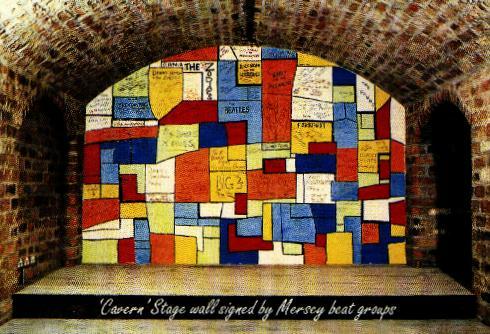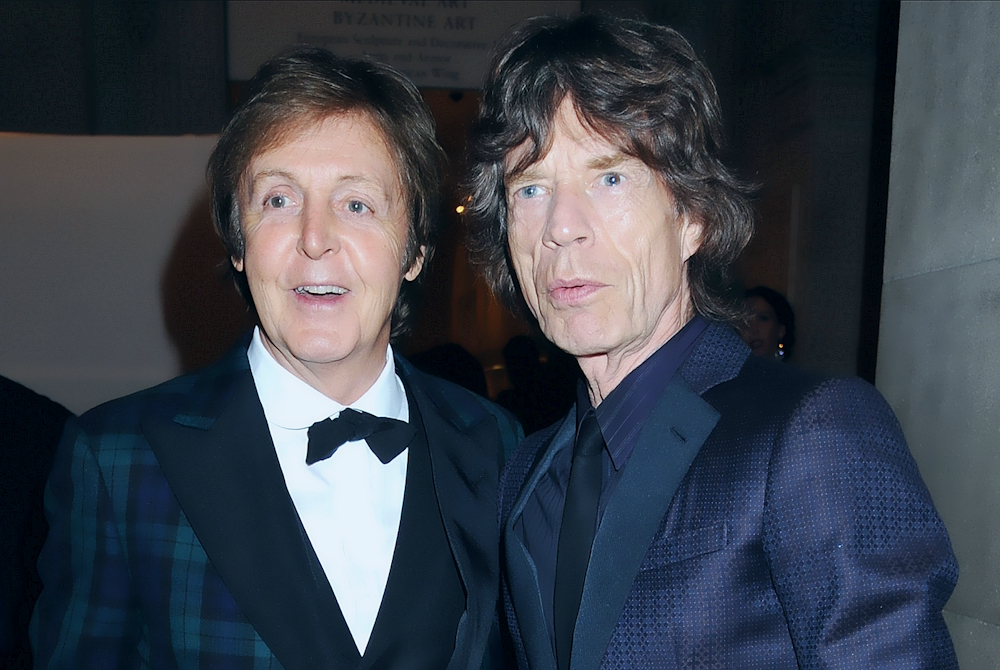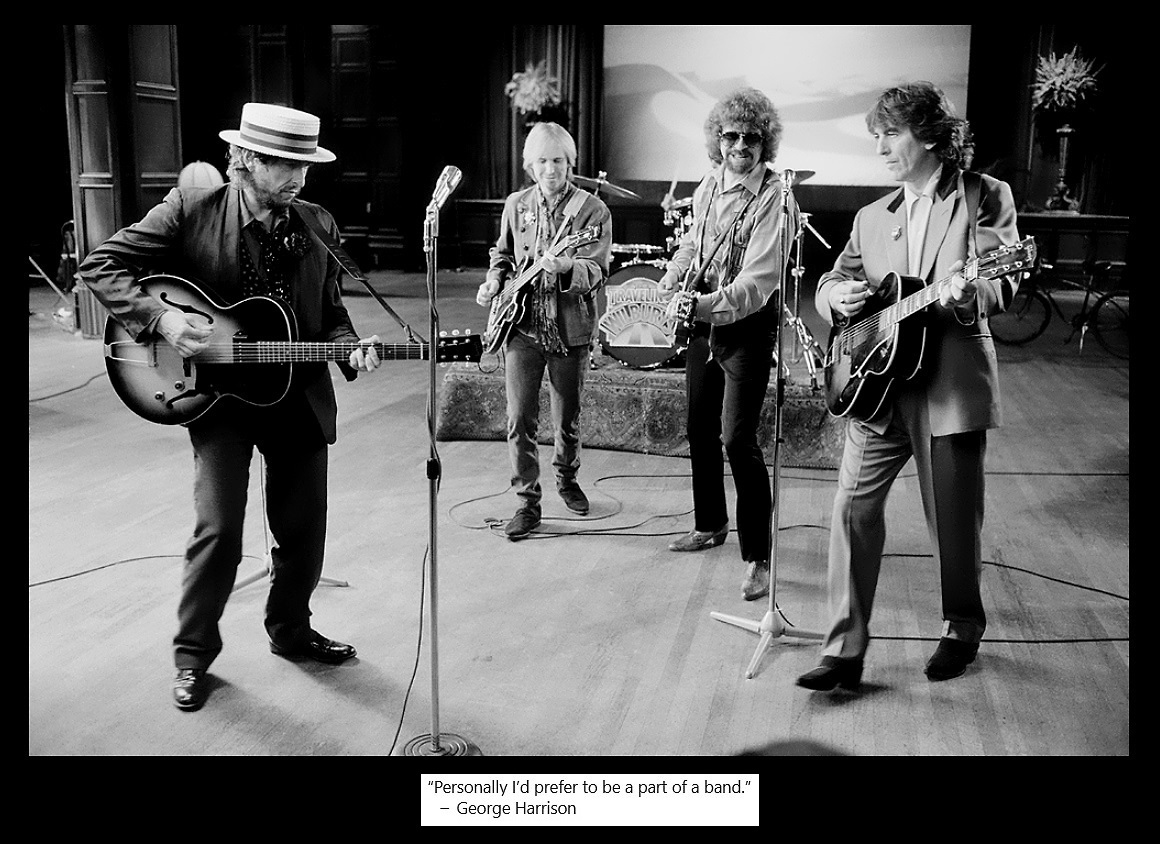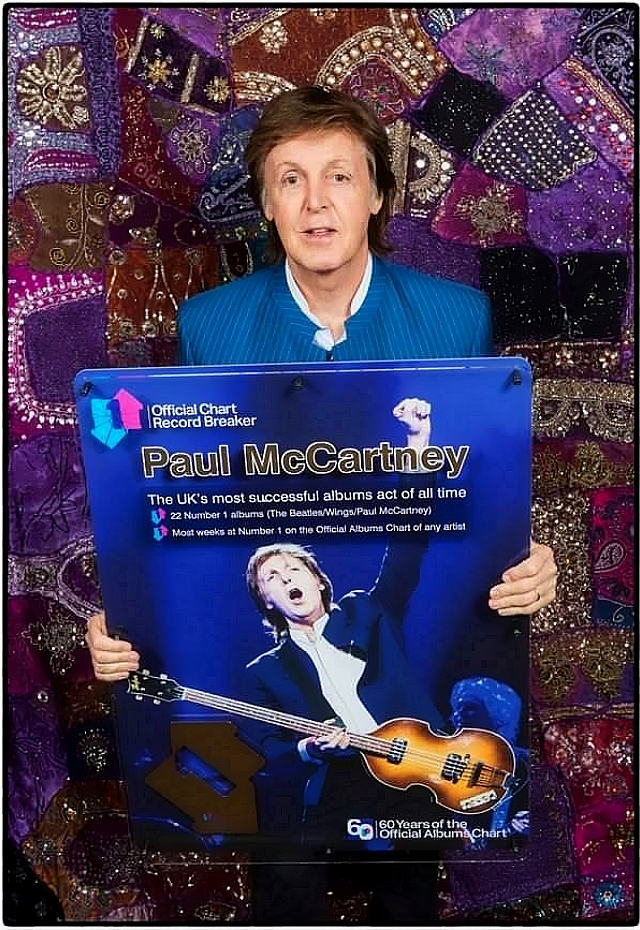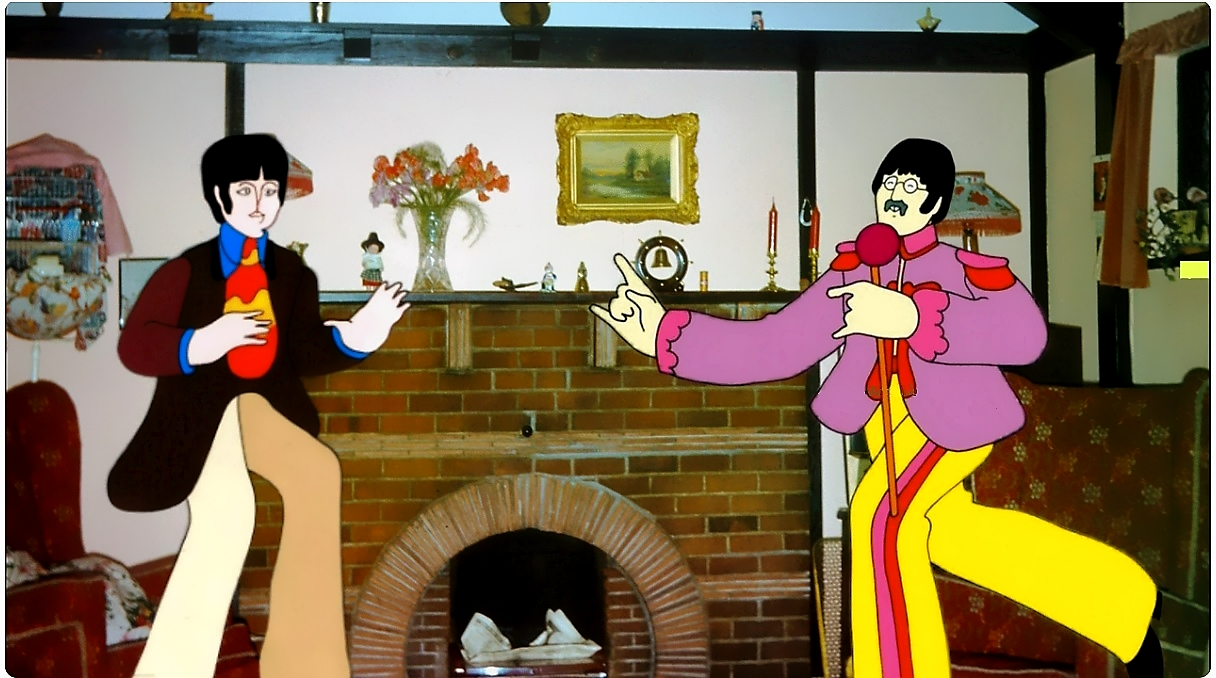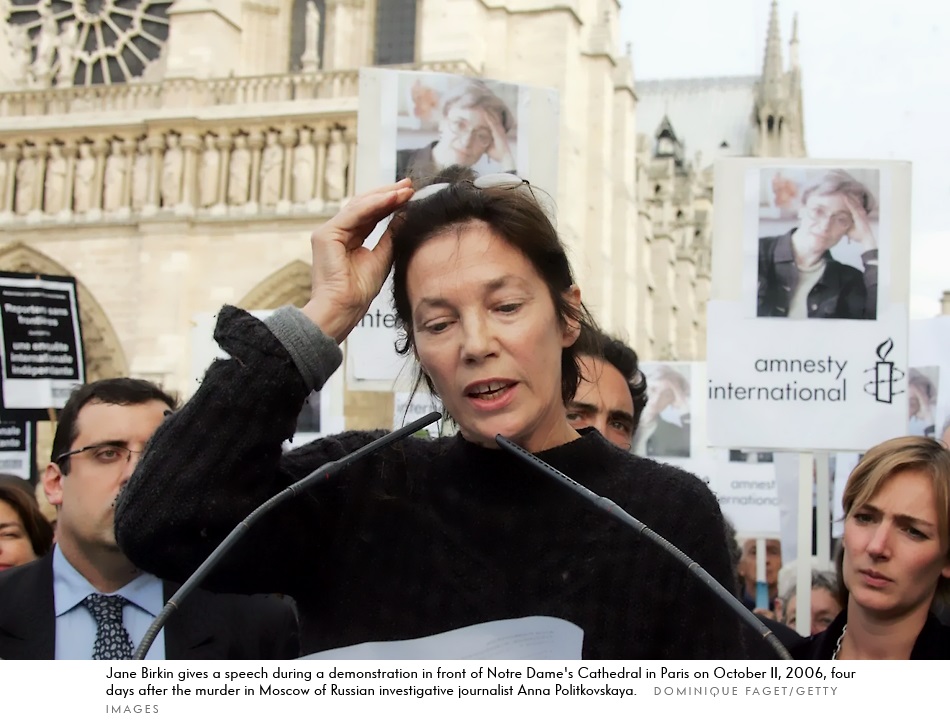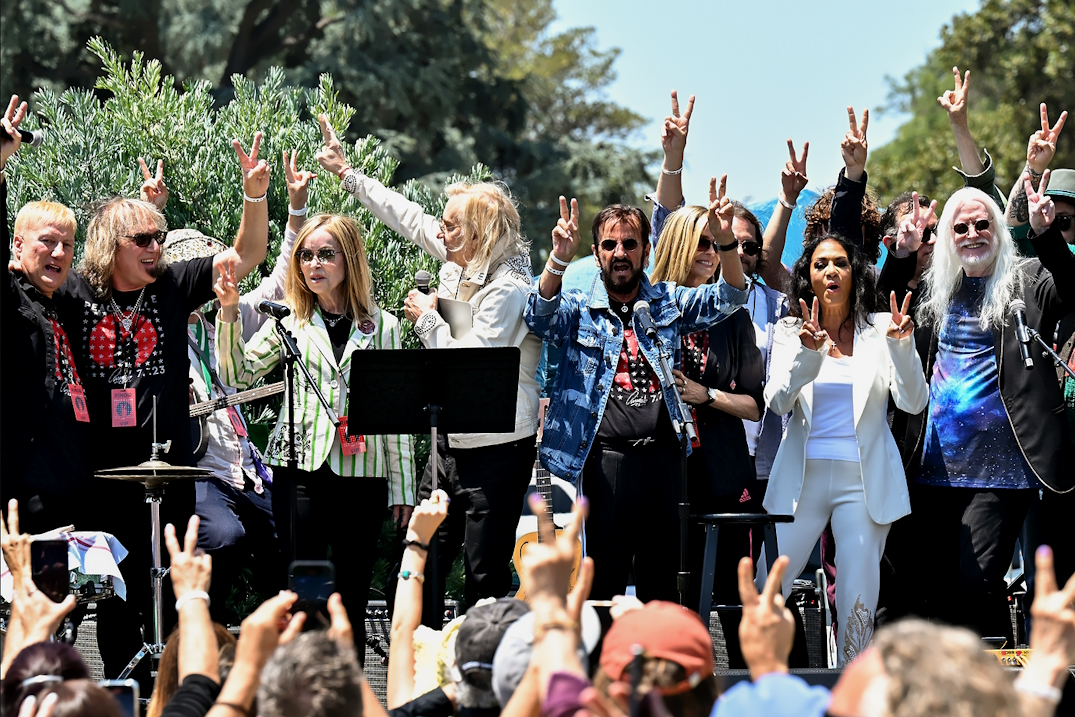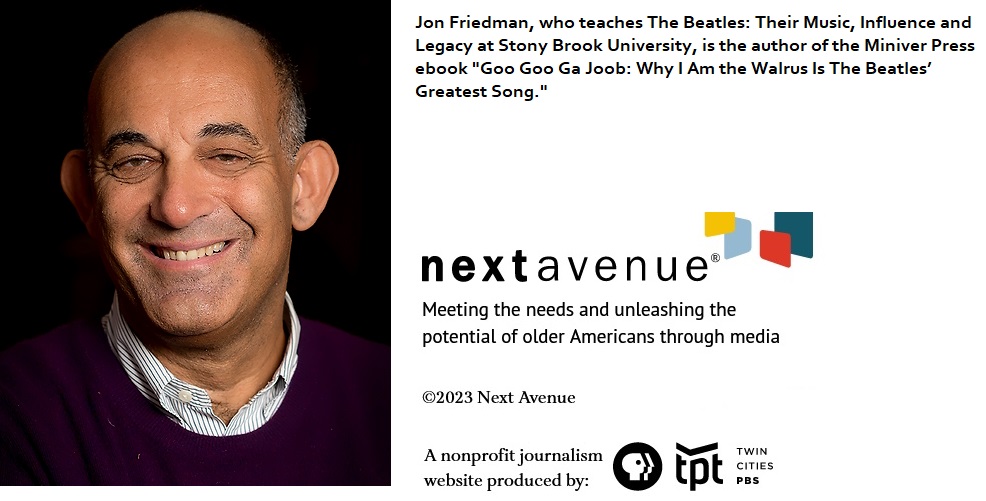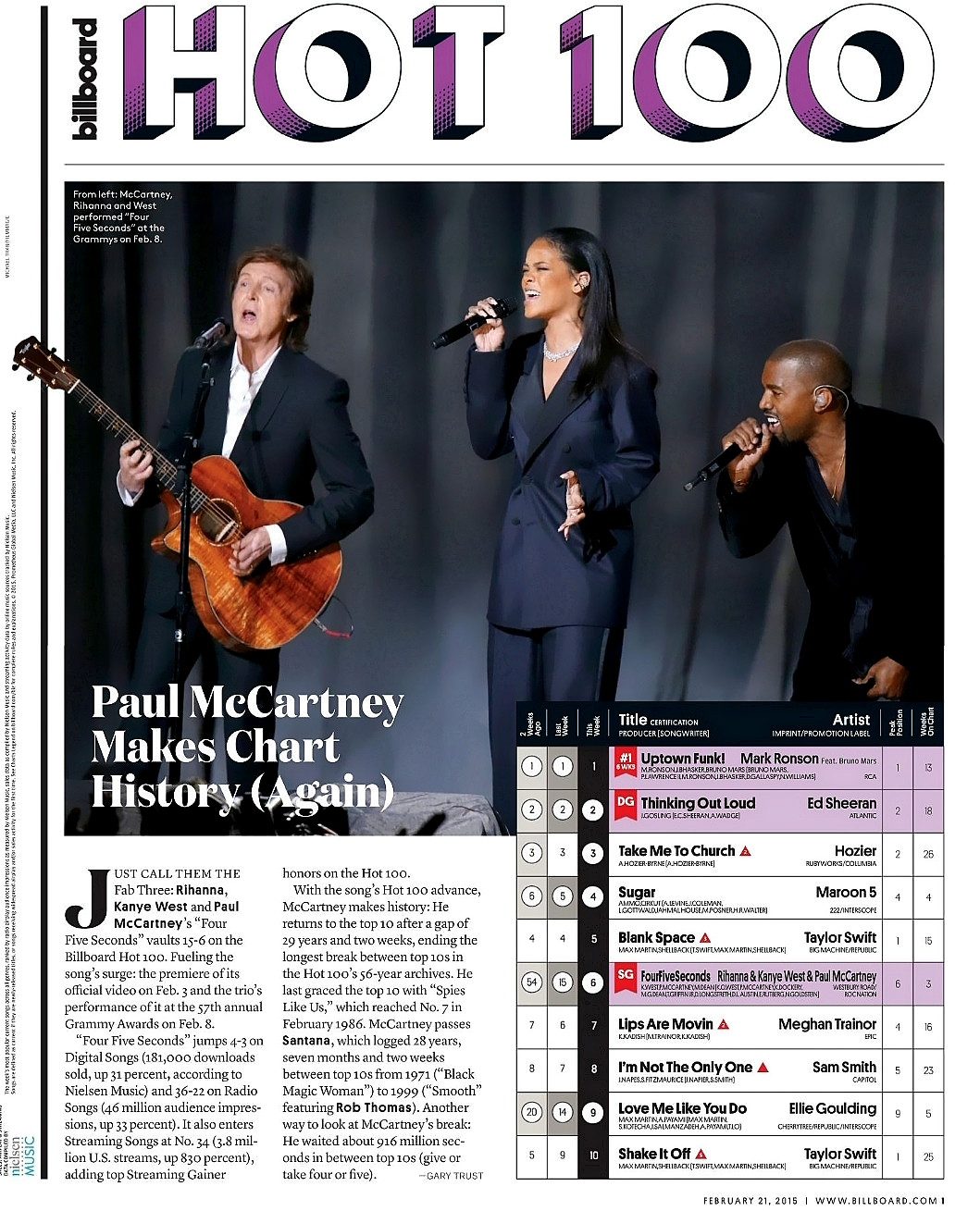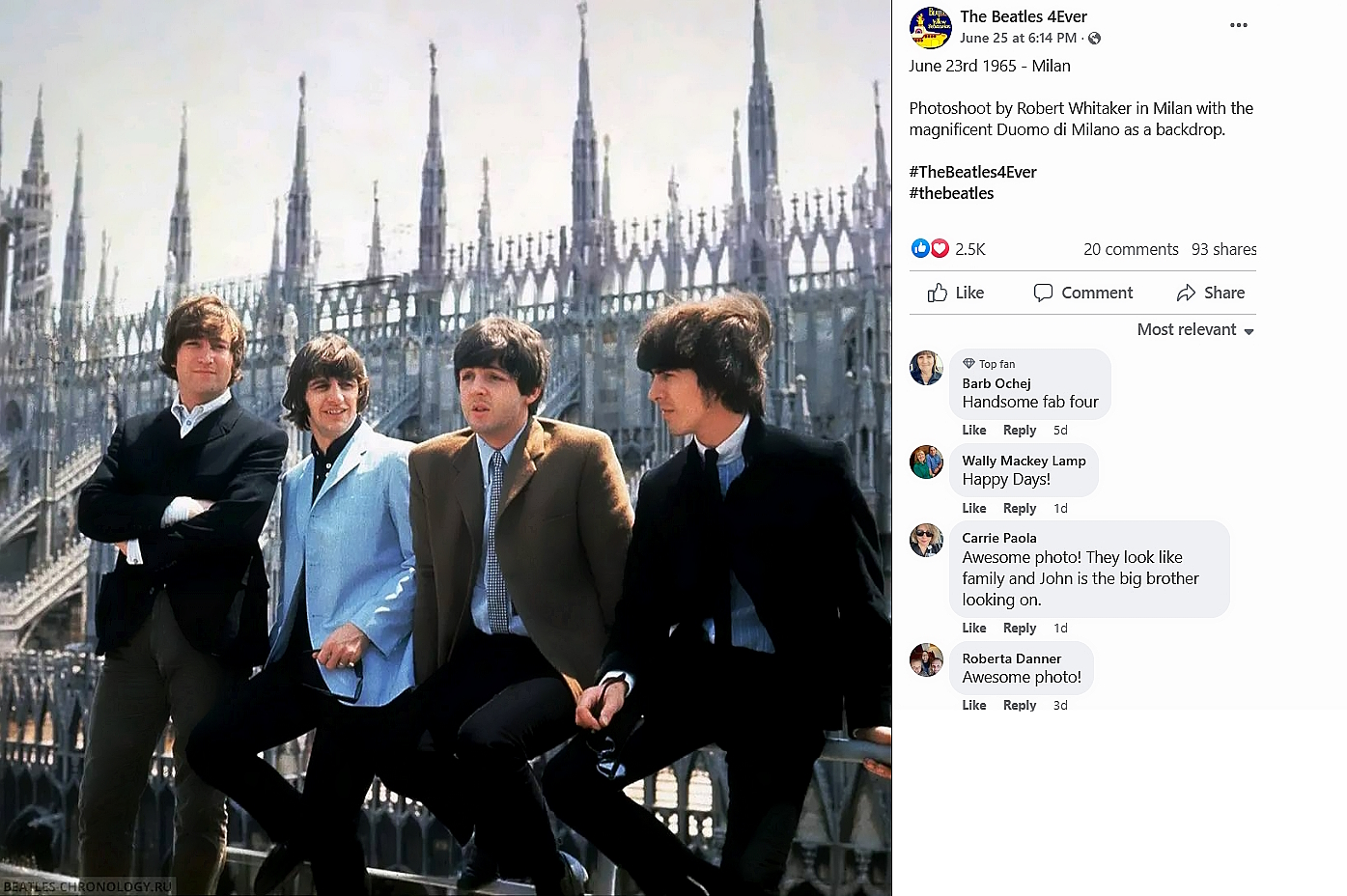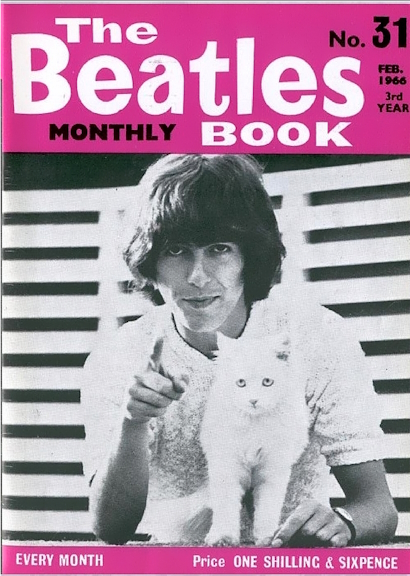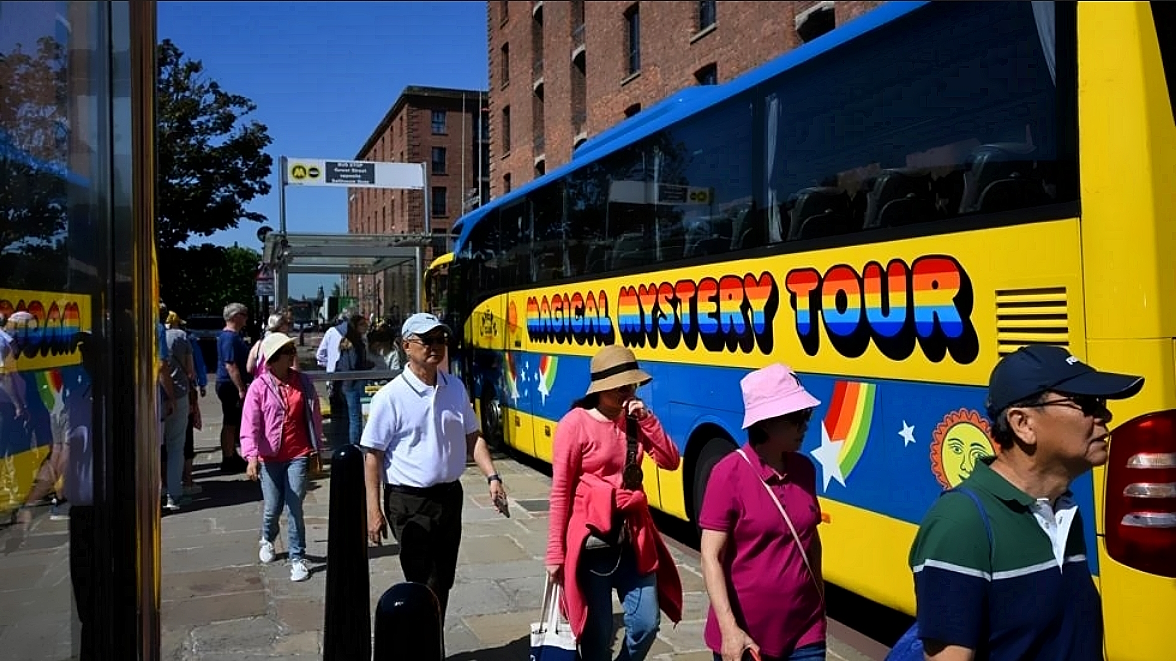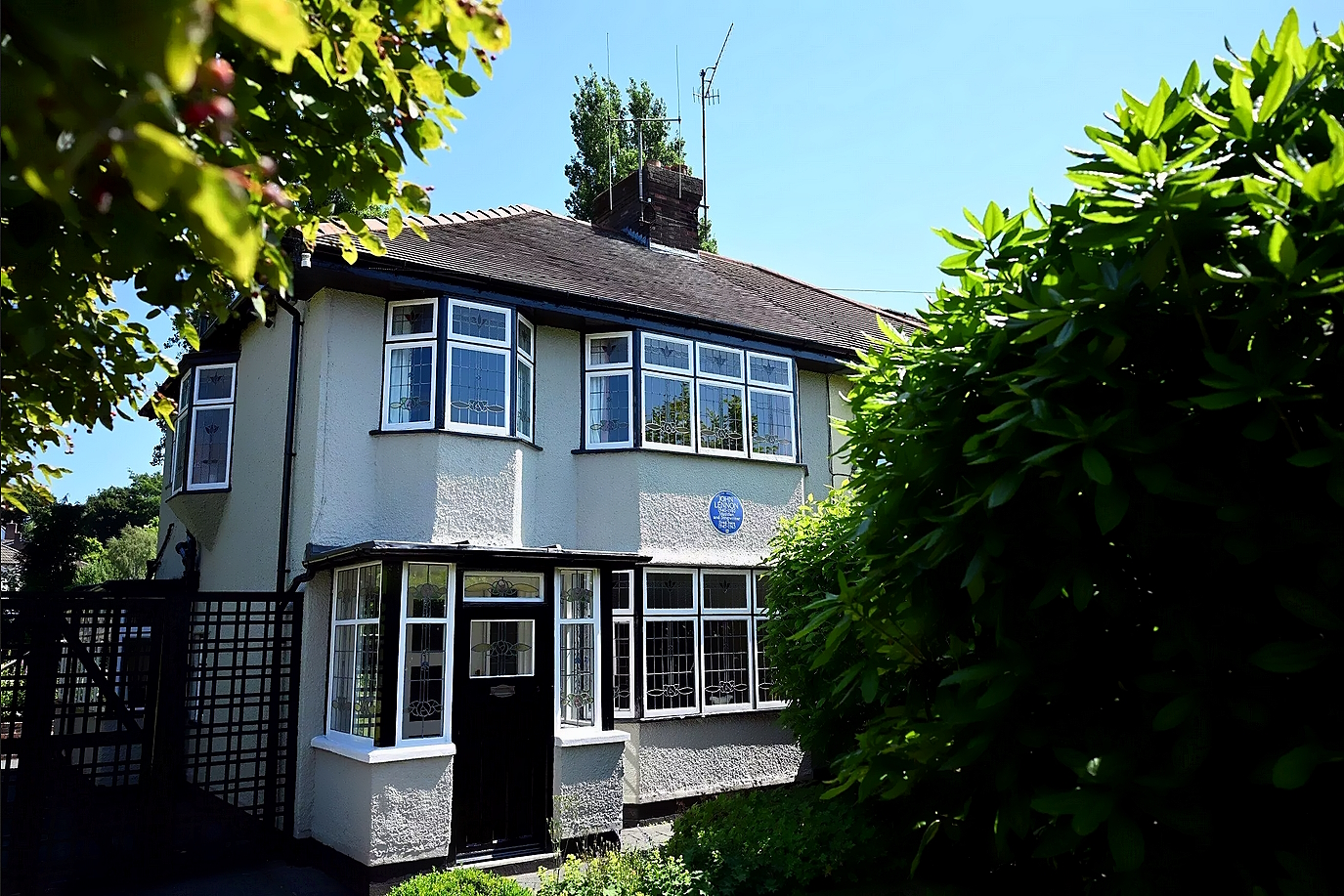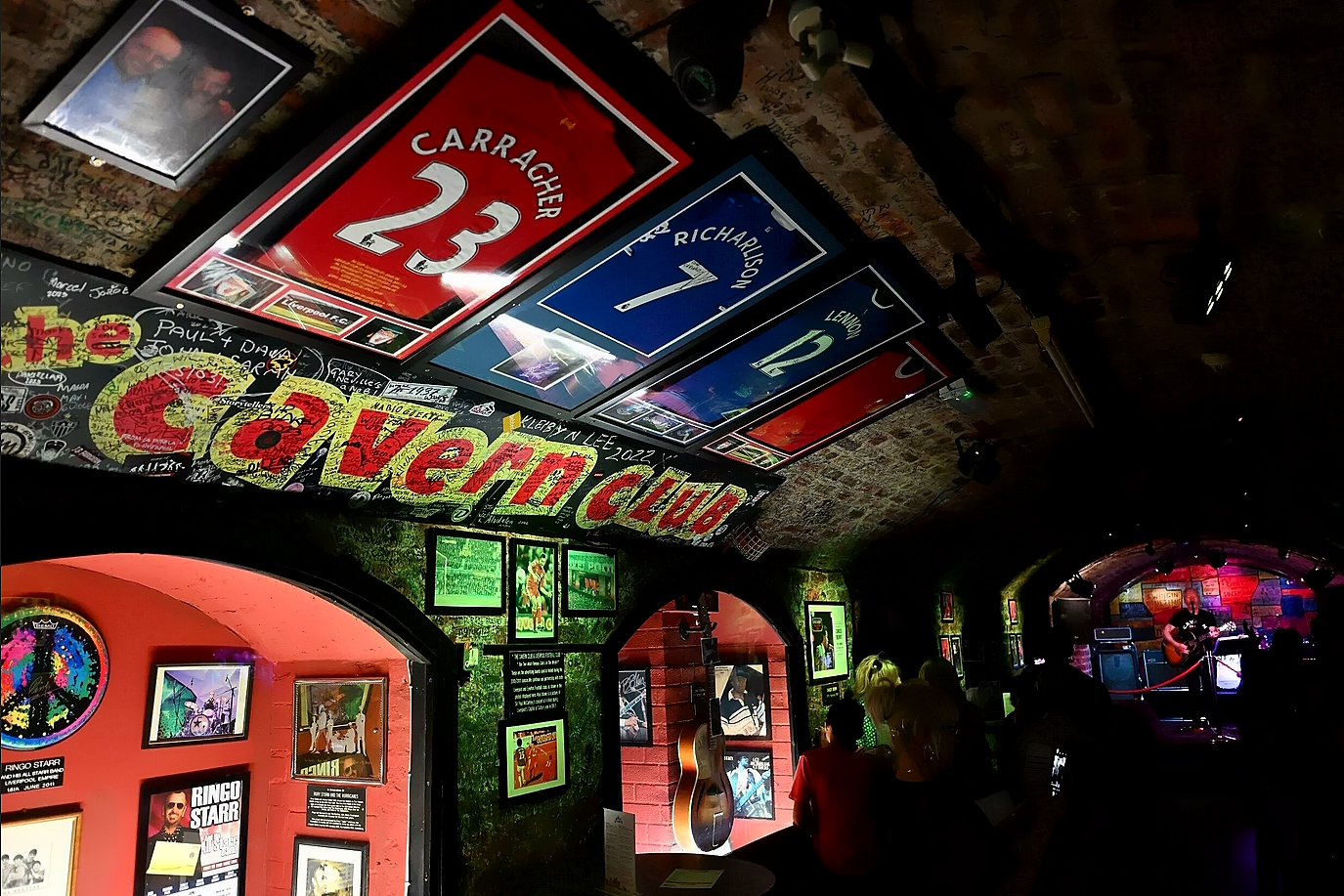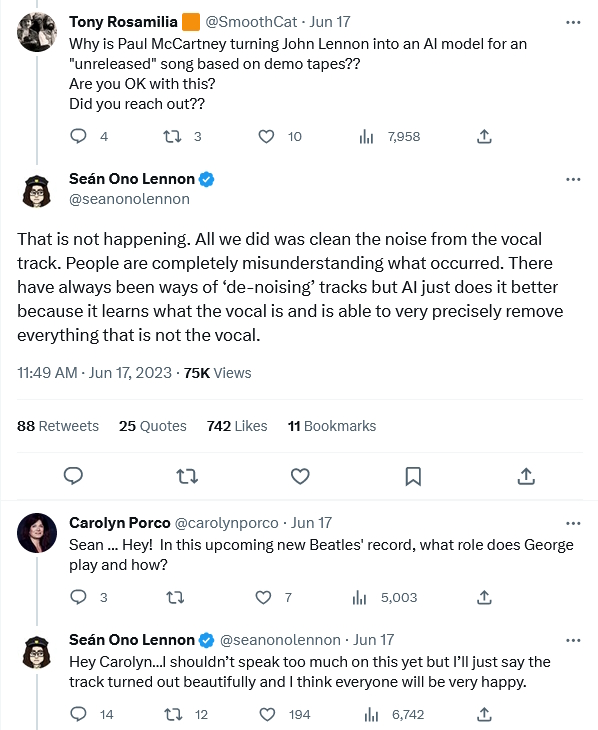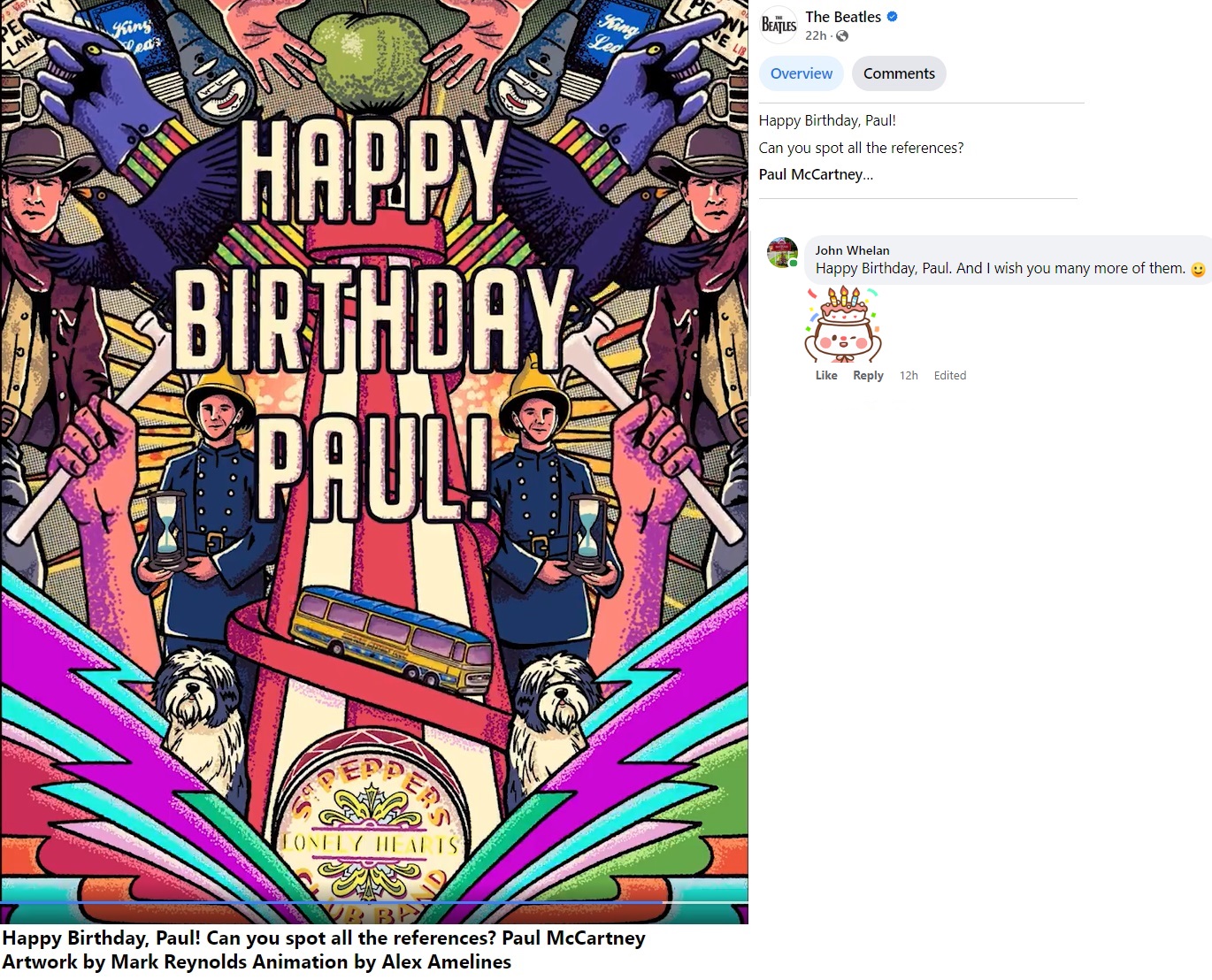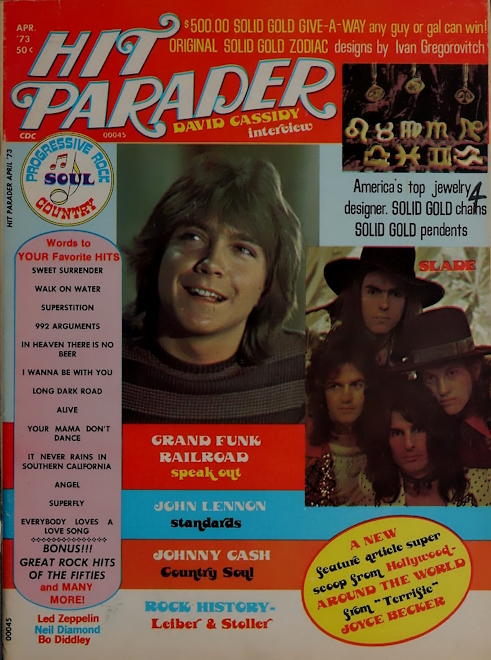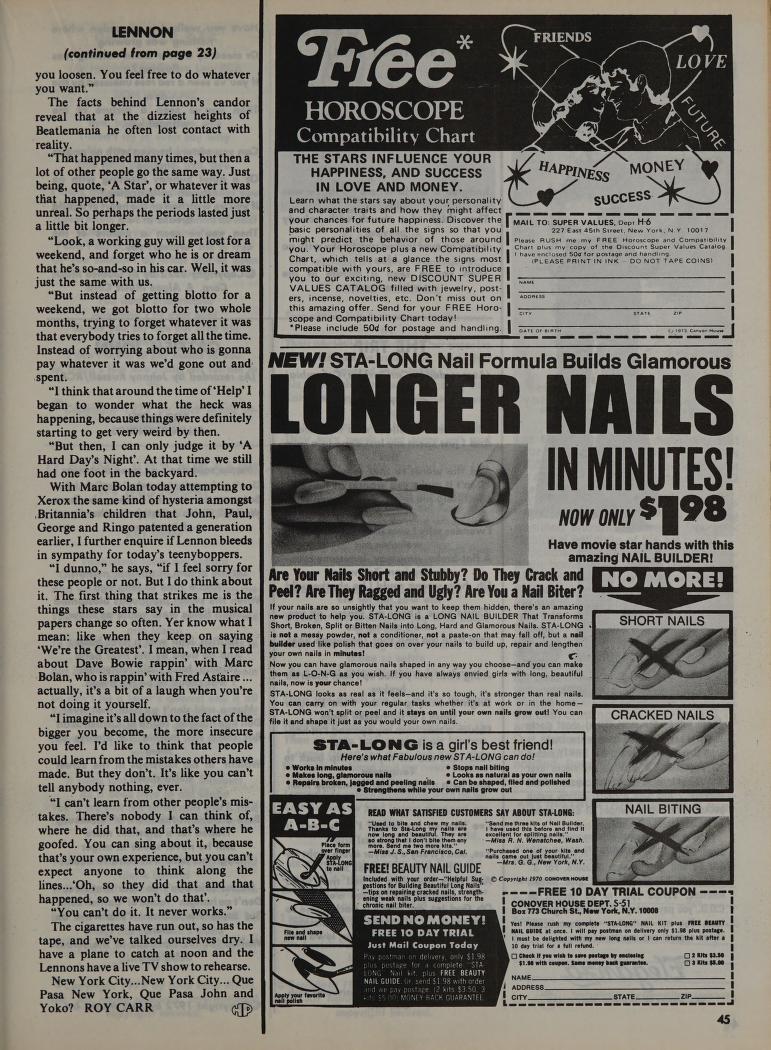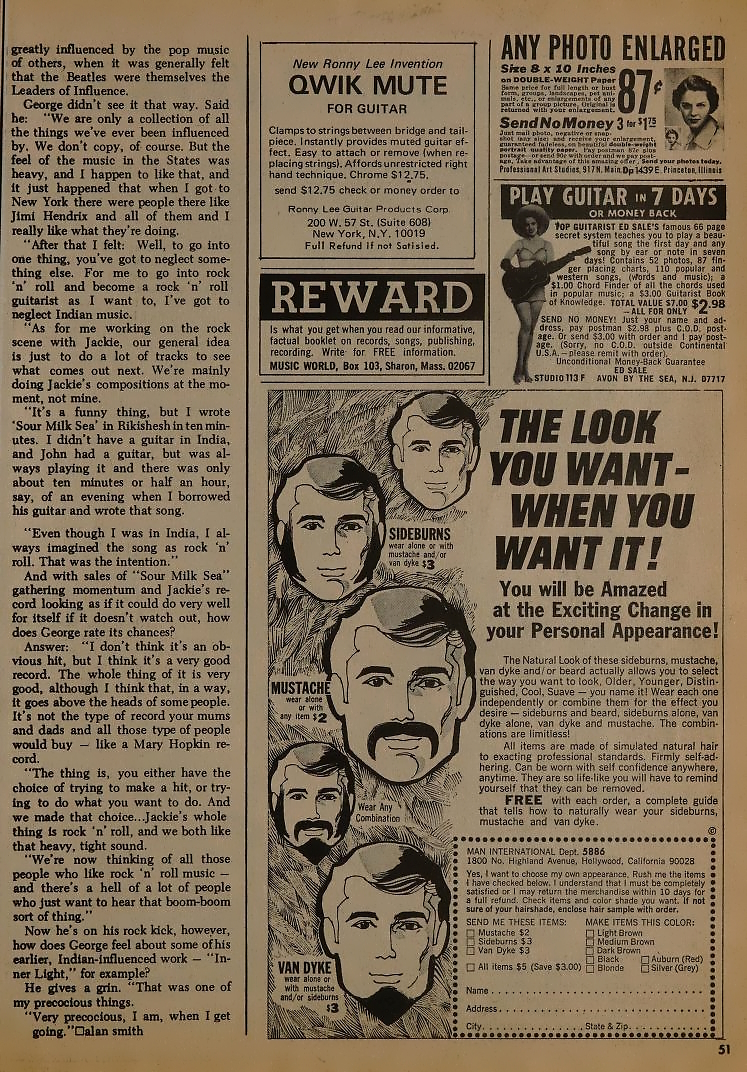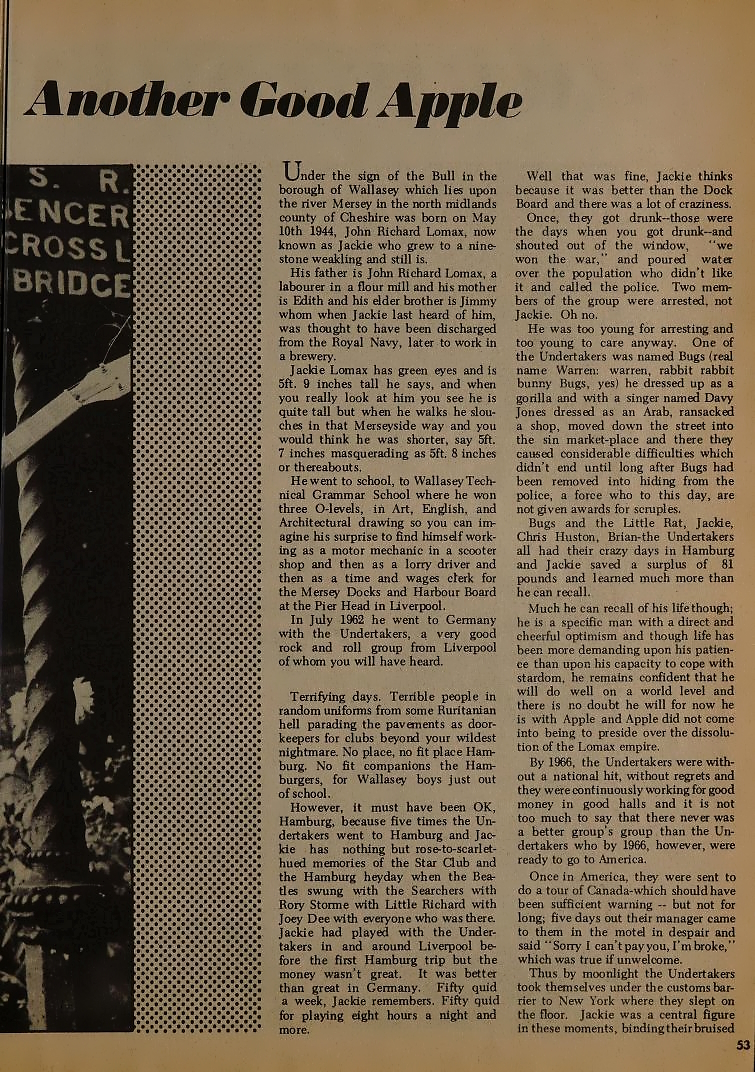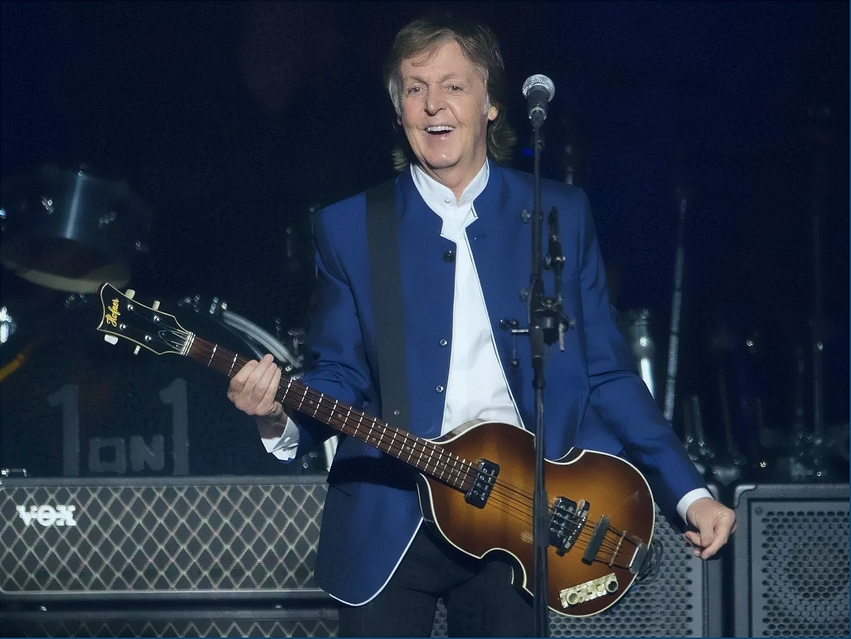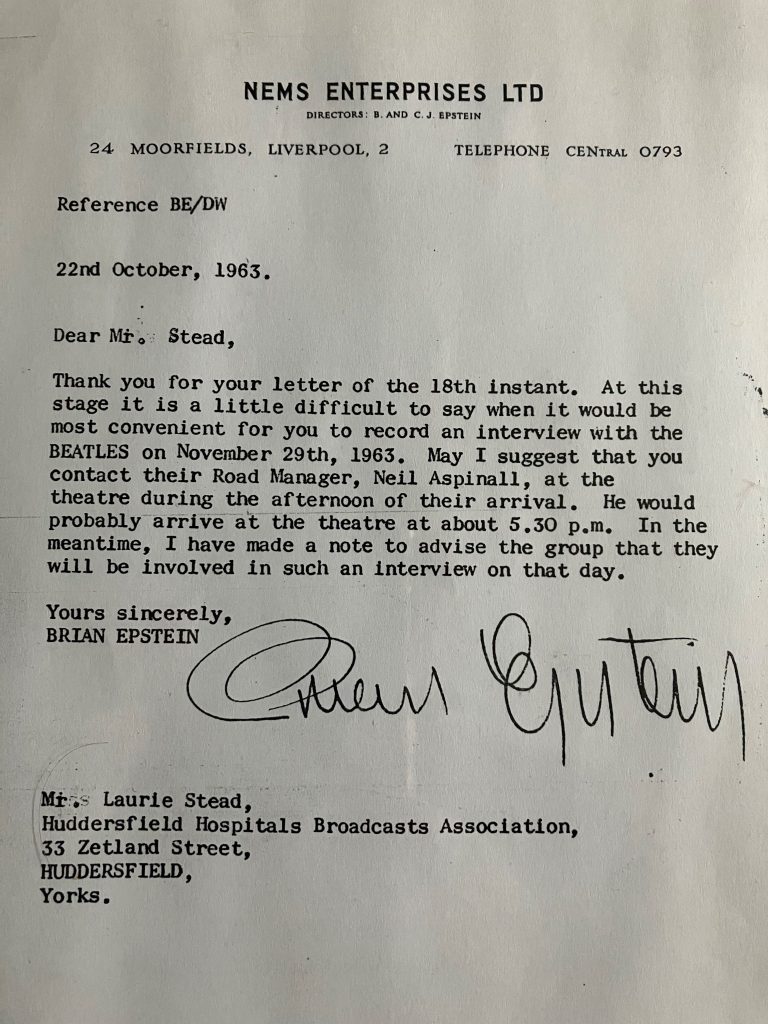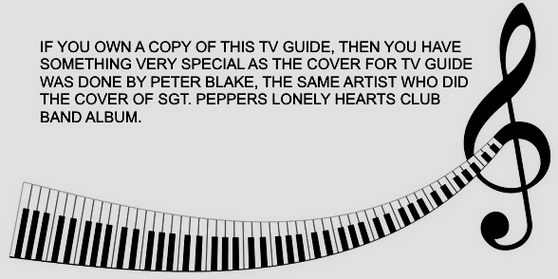|
| ||||||||||||||||||||||||||||||||||||||||||||||||||||||||||||||||||||||||||||||||||||||||||||||||||||||||||||||||||||||||||||||||||||||||||||||||||||||||||||||||||||||||||||||||||||||||||||||||||||||||||||||||||||||
|
The News Today
July 26, 2023 Happy 80th Birthday Michael Philip Jagger from the Ottawa Beatles Site
Rare photo of George Harrison and the Traveling Wilburys
 July 25, 2023 "They stole our ideas" – John Lennon on the Yellow Submarine film and the unexpected Beatles recording of its soundtrack song, Hey Bulldog by Rob Laing for Music Radar "We had nothing to do with that movie"
The 1968 animated film of Yellow Submarine is inextricably linked with the Beatles – not just their music but their imagination, ideas and identity. But, with the exception of one scene to meet a contractual obligation, the voices of the band featured in the film were provided by actors and not John, Paul, Ringo and George. It later emerged that John Lennon in particular was unsatisfied with the creative involvement the band had and not receiving credit for the ideas they had provided for the film.
YouTube channel Beatles Bible recently cast Lennon's views on the film in a stark light – using audio from The Lost Lennon Tapes radio series that features Lennon's 1980 interview with David Sheff for Playboy, he doesn't hold back when talking about the background to the exclusive song the Beatles provided for the film's soundtrack; Hey Bulldog. He described the people involved in the film as "gross animals" – with the exception of artist Alan Aldridge, who had first illustrated the Yellow Submarine in November 1966 following the Beatles' Revolver album.
Lennon accused the film's writer of "lifting all the ideas for the music out of our heads and not giving us any credit, like Eric Segal writing Lennon-esque lines straight from [Lennon's 1964 poetry and short stories book] In His Own Write-style".
"We had nothing to do with that movie," Lennon added, referencing contractual obligation to former American production and distribution company United Artists. "We sort of resented them… it was the third movie we owed these United Artists and Brian [Epstein, Beatles manager] had set it up and we had nothing to do with it."
The context may well have been the Lennon's growing dissatisfaction with the Beatles' involvement in film. Though the band clearly enjoyed 1964's A Hard Day's Night, Lennon was reportedly less enamored with the band's control over 1965's Help and 1967's The Magical Mystery Tour had been poorly received by critics and audiences, despite the success of its soundtrack.
Lennon did enjoy the finished movie but noted where some of its characters had come from. "I like the movie, I like Heinz's [Edelmann, illustrator] artwork but they got all the ideas for the glove in the sky, and the thing that sucks people up was my idea. They said, 'Have you got any monsters?' and I said , 'Yeah there's Horace the vacuum cleaner in the swimming pool'. Which was a thing you could buy and it went round the pool sucking up the things. I said, 'That could be a monster'. They just took him…"
Lennon's pool monster creation features in Beatles Book Monthly, No. 52, Nov. 1967 - accompanying an article called John At Home, Part Two.
Aside from his own score, the film's soundtrack features a host of Beatles favourites along with the title track. Hey Bulldog was noted in being a new song to Beatles fans that hadn't been released before. But Lennon seems slightly dismissive of it in the interview.
"It's a good-sounding record that means nothing – nice lick on the piano and all that."
Though it's credited as a Lennon-McCartney song, Lennon described it as "me" in the Sheff interview, though it shares the distinction with McCartney's Lady Madonna as being a Beatles songs based around a piano riff.
"I remember Hey Bulldog as being one of John’s songs and I helped him finish it off in the studio, but it’s mainly his vibe," noted McCartney in Barry Miles's book Paul McCartney: Many Years From Now. "There’s a little rap at the end between John and I, we went into a crazy little thing at the end."
Hey Bulldog was recorded during what was supposed to be a filming session for the Beatles' promo video for the 1968 Lady Madonna single, which would be backed by Harrison's The Inner Light as the b-side. This explains why a video exists of the song – the Lady Madonna camera crew remained in the studio filming as the Lennon and McCartney worked on Hey Bulldog. But the footage captured that day would remain lost for 30 years. "On February 11, they recorded Hey Bulldog at Abbey Road, while I filmed the entire process", remembered friend of the band Tony Bramwell in his book Magical Mystery Tours: My Life With The Beatles. "We didn’t need any promo material for Bulldog, but Paul had also recorded Lady Madonna, the song he had written in memory of his mother, which did need some promotional film. I cut the Bulldog shoot, using the bits of the lads playing and sitting about in the studio, and we used that. Then it vanished, completely disappeared. "We thought it had been stolen, as things often were if not nailed down. Over thirty years later, in August 1999, my original film was rediscovered and used with a reissue of Bulldog to go with the revamped digital version of Yellow Submarine." And you can see that footage above. Lennon had originally titled the song 'Hey Bullfrog" and reportedly got its name when Paul McCartney tried to make Lennon laugh by barking like a dog during the recording of the song's basic track. This new title appears in the outro's vocals and producer George Martin and engineer Geoff Emerick left McCartney's barking in, alongside shouting and screaming noises from the two songwriters.
"That was a really fun song," Emerick recalled to Mark Lewis for The Complete Beatles Recording Sessions. "We were all into sound texture in those days and during the mixing we put ADT on one of the ‘What did he say? Woof woof’ bits near the end of the song. It came out really well."
The song's tenth take was decided to be the best, with George Harrison adding a distorted intro with his SG, later borrowed by Lennon to track the solo.
Emerick was especially impressed with McCartney's bass playing on the song, and he would cite it as one of the Beatles' final true group efforts in the studio with equal musical contributions. Days after they would fly to India to study meditation with Maharishi Mahesh Yogi.
Along with the Beatles' other songs from the soundtrack, in 1999 it would be one of the first times the band's music had been remixed, completed by Peter Cobbin at Abbey Road Studios using the original multitrack tape and released as the Yellow Submarine Songtrack. Only Sgt Pepper cut A Day In The Life is absent – it was used in the film but never appeared on the musical soundtrack release.  July 24, 2023 Smile Away Paul, just simply Smile Away! :) :)
 July 23, 2023 Paul McCartney pays tribute to Tony Bennett
Mike Pinder of the Moody Blues introduces the "Mellotron" to the Beatles
The following is an excerpt from Louder magazine by Rob Hughes
The Moody Blues had hit big with Go Now, a Larry Banks cover that topped the UK singles chart in January 1965. But they failed to build on the momentum: there’d been a flop album of R&B songs, a number of personnel changes and a steady stream of 45s that made no impression at all. Their label, Decca, were becoming increasingly desperate. By the time they paired the band up with staff producer Tony Clarke, ostensibly to record music as a sales tool for the label’s new Deramic Stereo Sound, the debts were piling up. Days Of Future Passed, a dawn-to-night concept album made in conjunction with the London Festival Orchestra, was greeted with barely suppressed horror by the company executives who bankrolled it. Only when it landed them a Top 30 hit on both sides of the Atlantic (in the US it actually reached No.3) were they prepared to give the band another chance.
The Moodies decided its follow-up would reflect their fascination with the culture that surrounded them. The Beatles had invited them along as support on their final tour of England in late ’65, after which the Fab Four bonded with Thomas and Moodies keyboard player Mike Pinder. During the next couple of years they could all be found hanging out at each other’s houses or at rock star drinking dens like the Bag O’Nails in Soho. “Ray and I were always popping into the Abbey Road sessions,” recalls Pinder. “And we both played on a couple of Beatles tracks – mouth organs and back-up harmonies on I Am The Walrus and Fool On The Hill.”
Pinder also introduced The Beatles to his favourite new toy: the Mellotron – a veritable mini-orchestra in the right hands. He outlined to them the possibilities it afforded to musicians with curious minds.
“The next day John, Paul, Ringo and George ordered one each,” he says. “It was very cool. I was knocked out for them, especially when I heard Strawberry Fields Forever. That was my reward.”
It was a reciprocal relationship. “Whatever the Beatles did, people followed,” says Moodies singer/guitarist Justin Hayward (who had replaced original frontman Denny Laine in late 66). “In the early part of 67 we’d started to read those books on Transcendental Meditation. The Beatles were the leaders of that particular club in London that we all went to. We didn’t get the Maharishi, though, we got the Indian waiter from down the road. But we really were looking at that mind-expanding stuff, and then TM turned it into a religion. It was a proper way of life – better than just hanging around and being stoned all the time.” Paul McCartney Will Open Up About His ‘Life in Lyrics’ in New Podcast
Building off his bestselling book, 'The
Lyrics,' the Pushkin and iHeartPodcasts
production will arrive this summer
by Kory Grow
for Rolling Stone
PAUL MCCARTNEY WILL reveal the stories behind some of his best-known songs, from his work in the Beatles and Wings through his solo career, on a new podcast, McCartney: A Life in Lyrics. Each episode will find him focusing on a single song — including “Eleanor Rigby,” “Let It Be,” and “Live and Let Die,” among others in the first season — in discussion with poet Paul Muldoon, who wrote the foreword to McCartney’s bestselling book, The Lyrics: 1956 to the Present.
All 12 of the first season’s episodes will be available to stream at once with a Pushkin+ membership when it premieres on Sept. 20. Otherwise, fans can start listening to the first episode via iHeartRadio, Apple, Spotify, and other podcast platforms that day. A new episode will come out every week.
“I wanted to become a person who wrote songs and wanted to be someone whose life was in music,” McCartney says in a trailer for the podcast. In the clip, Muldoon explains how, over several years of picking apart McCartney’s words with McCartney himself, they realized that the book, The Lyrics, could double as an autobiography since some of the songs drew from themes that dated back to the songwriter’s childhood. “It was like going back to an old snapshot album, looking back on work I haven’t thought much about for quite a few years,” McCartney says.
In addition to the songs above, Season One of the podcast will feature episodes about “Back in the USSR,” “When Winter Comes,” “Penny Lane,” “Uncle Albert/Admiral Halsey,” “Here Today,” “Magical Mystery Tour,” “Jenny Wren,” “Too Many People,” and “Helter Skelter.” Season Two will come out in February and will focus on 12 more songs.
“When we listened back to the tapes, we realized there was something very special happening in these conversations,” Muldoon said in the podcast’s prologue. “It was McCartney unfiltered.”
In addition to the podcast, McCartney will fulfill his dream of being a paperback writer this fall when The Lyrics: 1956 to the Present arrives in softcover. The book will include bonus commentary that didn’t make it into the original edition about “Bluebird,” “Day Tripper,” “English Tea,” “Every Night,” “Hello Goodbye,” “Magical Mystery Tour,” and “Step Inside Love.” The paperback arrives Nov. 7.
 July 22, 2023 "Take Me Back" - An exciting new track that features "Paul McCartney and John Lennon AI voices"
Let It Be...Naked - Worthy or worthless? by Andrew of Parlogram Auctions Released 20 years ago, Let It Be..Naked was a radical re-working of the 1970 'Let It Be" album which not only re-imagined the album but which completely removed Phil Spector's production. Praised on it's release it is today in the wake of the recent remix and Get Back film as irrelevant. In this video we look at not just the history of the project but its sound quality and reputation and ask if in 2023, it's worthy or worthless.  July 21, 2023 From Ringo Starr's Facebook pages
 July 19, 2023 Wouldn't We Be Curious to Know What Thoughts Albert Einstein Would Have Had about the Beatles Music?
 July 18, 2023 Mosaic tribute to John Lennon revealed at Strawberry Field in Liverpool by The Guide Liverpool
Crafted by Mozaico, the artwork is made up of 390,000 individual hand-cut tiles. Artwork, referencing one of The Beatles’ most recognisable songs, is paying tribute to the late John Lennon at Strawberry Field in Liverpool.
Created by Mozaico, a leading mosaic art producer, the piece draws inspiration from the Imagine mosaic in the Strawberry Fields memorial at Central Park, New York City. A whopping 6.4 meters in diameter – larger than its New York counterpart – the mosaic artwork was crafted over 16 consecutive weeks using 390,000 individual hand-cut tiles.
Chady Tawil, CEO at Mozaico, said: “It’s been a pleasure working with The Salvation Army to pay tribute to John Lennon’s life, talent and creativity, while also reflecting the core virtues of peace, tranquility and love as a harmonious continuation of the charity’s mission.
“We hope the mosaic will become a new attraction as a part of Strawberry Field’s new bandstand, becoming a platform for musical and theatrical performances.”
Assembling the artwork by hand ensured the unmatched quality and durability of the design, which is essential for preserving its condition, given its installation in a public space.
Strawberry Field holds a special place in the hearts of music enthusiasts and fans of the iconic band, The Beatles.
The site gained fame through the eponymous song, “Strawberry Fields Forever”, and was originally a Salvation Army children’s home. It now stands as a vibrant visitor attraction.
It offers a mix of history, art, and inspiration, with interactive exhibitions showcasing The Beatles’ early lives and the impact of the song.
Visitors can explore the tranquil gardens, visit the Strawberry Field exhibition, and immerse themselves in the story behind this legendary place.
Strawberry Field is a must-visit destination for Beatles enthusiasts and music lovers alike, offering a unique and nostalgic experience in the heart of Liverpool. From The Beatles Official Facebook pages...
 July 17, 2023 Jane Birkin, lead actress in the movie production of "Wonderwall," has passed away. She was 76. London-born star was celebrated for her natural style, social activism by the Associated Press via CBC News
Actor and singer Jane Birkin, who made France her home and charmed the country with her English grace, natural style and social activism, has died at age 76.
The London-born star and fashion icon was known for her musical and romantic relationship with French singer Serge Gainsbourg. Their songs notably included the steamy Je t'aime moi non plus (I Love You, Me Neither).
Birkin's ethereal, British-accented singing voice interlaced with his gruff baritone in the 1969 duet that helped make her famous and was forbidden in Italy after being denounced in the Vatican newspaper.
The style Birkin displayed in the 1960s and early 1970s — long hair with bangs, jeans paired with white tops, knit mini dresses and basket bags — still epitomizes the height of French chic for many women around the world.
Birkin was also synonymous with a Hermes bag that bore her name. Created by the Paris fashion house in 1984 in her honour, the Birkin bag became one of the world's most exclusive luxury items, with a stratospheric price tag and years-long waiting list to buy it. Activism In her adopted France, Birkin was also celebrated for her political activism and campaigning for Amnesty International, Myanmar's pro-democracy movement, the fight against AIDS and other causes.
"You can always do something," Birkin said in 2001, drumming up support for an Amnesty campaign against torture. "You can say, 'I am not OK with that."'
She joined five monks on a march through the Cannes Film Festival in 2008 to demand that Myanmar let foreign aid workers into the country to help cyclone victims.
In 2022, she joined other screen and music stars in France in chopping off locks of their hair in support of protesters in Iran. Charlotte Gainsbourg, Birkin's daughter with Gainsbourg and also an actor in her own right, cut off a snippet of her mother's hair for the "HairForFreedom" campaign as Iran was engulfed by anti-government protests. 'The most French British person' French President Emmanuel Macron hailed Birkin as a "complete artist," noting that her soft voice went hand-in-hand with her "ardent" activism.
"Jane Birkin was a French icon because she was the incarnation of freedom, sang the most beautiful words of our language," he tweeted.
French media reported that Birkin was found dead at her Paris home. The French Culture Ministry tweeted that Birkin died Sunday. It hailed her as a "timeless Francophone icon."
Culture Minister Rima Abdul Malak called Birkin "the most French British person" and "the emblem for a whole epoch who never went out of fashion."
Outside Birkin's home on Paris's Left Bank, fans mourned her death.
"She was a poet, a singer, an artist," said Marie-Jo Bonnet. "She gave the best of herself and that's marvellous."
Birkin's early movie credits included Blow-Up in 1966, credited with helping introduce French audiences to her "Swinging Sixties" style and beauty.
Birkin and Gainsbourg met two years later. She remained his muse even after the couple separated in 1980.
She also had a daughter, Kate, with James Bond composer John Barry. Kate Barry died in 2013 at age 46. Birkin had her third daughter, singer and model Lou Doillon, with French director Jacques Doillon. Health issues Birkin suffered from health issues in recent years that kept her from performing and her public appearances became sparse.
French broadcaster BFMTV said Birkin suffered a mild stroke in 2021, forcing her to cancel shows that year. She cancelled her shows again in March due to a broken shoulder blade.
A return to performing was put off in May, with the singer saying she needed a bit more time and promising her fans she would see them again come the fall. Birkin bag Despite her decades-long screen and music career, Birkin suspected that, for some people, the bag named after her might be her most famous legacy.
The fashion accessory was born of a fortuitous encounter on a London-bound flight in the 1980s with the then-head of Hermes, Jean-Louis Dumas. Birkin recounted in subsequent interviews that they got talking after she spilled some of her things on the cabin floor. She asked Dumas why Hermes didn't make a bigger handbag and sketched out on an airplane vomit sack the sort of bag that she'd like.
Dumas then had an example made for her and, flattered, she said yes when Hermes asked whether it could commercialize the bag in her name.
In a CBS Sunday Morning interview in 2018, Birkin joked that it might be what she's best known for.
"I thought, 'Oh gosh, on my obituary, it will say, 'Like the bag' or something,"' she said. "Well, it could be worse."  July 15, 2023 The Secret History of the Beatles’ ‘Let It Be’ Legendary producer Glyn Johns and Ringo Starr share tales of the album that should have been — and Johns recalls working with the Stones, Zeppelin and The Who by Brian Hiatt for Rolling Stone
Producer/engineer Glyn Johns recorded the whole of the Let It Be sessions for the Beatles in 1969, and mixed a raw version of the album that wouldn’t be released for another 52 years — so he’s far from a fan of the Phil Spector-embellished album that came out in 1970. “He did a terrible job,” Johns says on the new episode of Rolling Stone Music Now. “Don’t misunderstand me — I respect Phil Spector for his early work tremendously. But somebody like Phil Spector shouldn’t ever be allowed near a band like the Beatles, in my view. Phil Spector was always the artist in the records that he made. He treated the artists like parts of the machine to make the end result. I don’t think the Beatles ever require that kind of input.”
The new episode, which also includes an interview with Ringo Starr, was recorded live at the Rock and Roll Hall of Fame on Starr’s 83rd birthday, with Rob Sheffield and Hall of Fame vice president of education Jason Hanley joining host Brian Hiatt to interview Johns about the making of Let It Be and more. To hear the whole episode — which also includes some of Johns’ memories of working with The Rolling Stones, the Who, and Led Zeppelin — go here to the podcast provider of your choice, listen on Apple Podcasts or Spotify, or just press play above. A few highlights follow:
Johns thinks the Beatles improved tremendously as players from their early days. “I had the good fortune to be present on a recording for a TV show they did in the very early sixties called Around the Beatles, and it was done at the studio where I was working,” Johns says. “And the backing tracks sounded pretty average, like any band really. I actually think they all developed tremendously as musicians from there, George in particular. George was not the most instinctive guitar player like Eric [Clapton] George needs time to sit and work stuff out, and when he does it is phenomenal. It’s just phenomenal. Ringo, I didn’t pay much attention to initially, but by the time I got to record them, it became apparent to me what an astonishing drummer he is, and I don’t think he gets nearly enough credit to this day. He really is quite remarkable. His feel. I’m talking about his feel. His technical ability is average, but his feel exceptional. Also, what he does, where he puts what he plays is quite remarkable. And without him, they would not have been the same band. I don’t care what anybody says.”
Starr has no idea
where he got the beat he plays on the
released version of “Get Back.”
When George Harrison temporarily left the Beatles during the making of Let It Be, it felt “very real,” Johns says. “Extremely real! He even took his eight track back. Talk about throwing your toys out the pram! I was really upset: ‘Bloody hell. I’ve waited all these years to work with them. I’ve been in it for two minutes, and it looks like it’s all over already.’ And of course, that turned out not to be the case, but it was pretty disappointing.”
With the notable exception of Harrison’s departure, there were few signs that the Beatles were nearly done as a band during the sessions. “It never entered my mind that they’d break up,” says Johns. “Obviously George leaving when he did was an awkward moment. But I think if George had have stayed gone, they’d have got another guitar player.”
Members of the Stones and the Beatles took an instant dislike to Led Zeppelin. “When Zeppelin set up and started to play, I was literally pinned to the back wall by what I heard,” says Johns, who engineered Led Zeppelin I the same year as the Let It Be sessions. “It was nothing like what I expected. But I remember taking the record and playing it to George Harrison on the way home from a Beatles session, and he didn’t like it at all. And I remember playing it to Mick Jagger, because I thought they should go on the Rock and Roll Circus [TV special]. And Mick didn’t like it at all either!”
Download and subscribe to Rolling Stone’s weekly podcast, Rolling Stone Music Now, hosted by Brian Hiatt, on Apple Podcasts or Spotify (or wherever you get your podcasts). Check out six years’ worth of episodes in the archive, including in-depth, career-spanning interviews with Bruce Springsteen, Mariah Carey, Halsey, Neil Young, Snoop Dogg, Brandi Carlile, Phoebe Bridgers, Rick Ross, Alicia Keys, The National, Ice Cube, Taylor Hawkins, Willow, Keith Richards, Robert Plant, Dua Lipa, Questlove, Killer Mike, Julian Casablancas, Sheryl Crow, Johnny Marr, Scott Weiland, Liam Gallagher, Alice Cooper, Fleetwood Mac, Elvis Costello, John Legend, Donald Fagen, Charlie Puth, Phil Collins, Justin Townes Earle, Stephen Malkmus, Sebastian Bach, Tom Petty, Eddie Van Halen, Kelly Clarkson, Pete Townshend, Bob Seger, the Zombies, and Gary Clark Jr. And look for dozens of episodes featuring genre-spanning discussions, debates, and explainers with Rolling Stone’s critics and reporters.  July 13, 2023 Sheila E. becomes first solo female percussionist honored on Walk of Fame by Hal Eisner for Fox 11 Los Angeles (with video) LOS ANGELES - Wednesday was a historic day in Hollywood as Sheila E. became the first and only solo female percussionist honored with a star on the Walk of Fame.
There were loud cheers as the star was unveiled and lots of love with the famous like Ringo Starr singing her praises. "Sheila was only 5 when she knew she wanted to be a percussionist — way ahead of me — I was 13 when I knew I only want to be a drummer," Starr said. "So you win." Singer H.E.R. called Sheila E. "a huge inspiration for me and such an important part of my artistry. So I thank you so much for representing women, for representing artists, musicians, for women who are musicians and getting that respect that we deserve because sometimes we're underestimated." Sheila E. attended the ceremony with a large crowd of friends and family, including her dad, drummer Pete Escavedo, whom she credited with influencing her to follow in his footsteps. She said as a teen, she wanted to be a gold medalist in the Olympics. In school, she was a track star. She also said she wanted to be the first woman astronaut on the moon, "however, God had a different plan for me. At 15 years old I played with my dad and realized, 'Wait a minute, this is what I'm supposed to be doing,' and I felt like playing music was the closest place I could be with God and, it was just a moment [that] changed my life. And I thought, 'Golly I'm not going to go to the Olympics. I'm not going to win a gold medal, and I'm not going to be an astronaut,' and so again God said you're going to win all of these gold albums and platinum albums which I have. He just flipped it, and I didn't become an astronaut. I'm always looking up to the stars. And today July 12, 2023, I'm a star here, and I'm so grateful for this." Sheila E.'s star is the 2,759th on the Hollywood Walk of Fame. It is in the 6700 block of Hollywood Boulevard, in front of the Musician’s Institute. − End of article
From Ringo Starr's Official Facebook pages
 July 12, 2023 More highlights from Ringo's 83rd birthday!
June 17, 2023 John Lennon Standardsby Roy Carr for Hit Parader magazine, April 1973
June 16, 2023 "George Harrison The Rocker" by Alan Smith + "Jackie Lomax Another Good Apple" by Derek Taylor
June 15, 2023 The Incredible Story of How a Guitar Magazine Helped Find John Lennon’s Long-Lost Gibson J-160EMissing since 1963, this iconic Beatles guitar was found over half a century later and sold at auction for $2.4 million by Christopher Scapelliti for Guitar Player
For its spring 2012 issue, the now-defunct Guitar Aficionado ran a cover feature about George Harrison’s most significant guitars, which were among the instruments featured in the then-new iPad app The Guitar Collection: George Harrison.
I was managing editor of Guitar Aficionado at the time, and one of the guitars we included in our story was George’s Gibson J-160E acoustic-electric. He and Lennon had each purchased that model in September 1962 at a Liverpool music store called Rushworth’s.
It’s these guitars you hear on early Beatles cuts like “Love Me Do” and “P.S. I Love You,” and Lennon’s guitar is most likely the one he used to write many of the group’s early hits, including “I Want to Hold Your Hand” and “Please Please Me.”
Oddly, at some point after purchasing the guitars, Lennon and Harrison swapped them with one another, either intentionally or perhaps accidentally, as they looked, for all intents and purposes, identical. Either way, it was Lennon’s instrument that went missing, presumed stolen, in December 1963, following the Beatles’ Christmas performances at the Astoria Cinema in Finsbury Park, London.
The guitar’s fate remained a mystery for the next 50 years. But in 2014, a U.S. guitarist named John McCaw spotted the Guitar Aficionado issue with the Harrison collection sitting on a pile of magazines.
Curious, he opened it and read about Harrison’s J-160E, noting that its serial number was only four away from that of the J-160E he’d purchased from a friend in 1969 for $175. He also noticed, in a photo of Lennon’s guitar, a few telltale spots similar to the wear and tear on his instrument.
Using a video of the Beatles performing “I Want to Hold Your Hand,” in which Lennon plays his J-160E, McCaw compared the guitars and noticed the pickguards had a similar pattern, leading him to contact Beatles gear expert Andy Babiuk.
With a little further sleuthing, McCaw learned that he was in fact the owner of John Lennon’s long-lost guitar, making it one of the most substantial gear finds in rock and roll history.
The Gibson went on to sell at auction for $2.4 million, with a portion of the proceeds going to Spirit Foundations Inc, a charity organization founded by Yoko Ono and John Lennon to help battle cervical cancer.
As a Beatles fan, I was thrilled to know our magazine had played a small role in solving the mystery of Lennon’s missing guitar.
− End of article.
A Rare Newsweek Magazine Cover That Has Authentic Signatures of The Beatles
 June 14, 2023 Paul McCartney says he used AI to create ‘the final Beatles record’AI was used to resurrect John Lennon’s voice, McCartney said. The final record will be released later this year, the legendary singer told the BBC in an interview.By
Tue., June 13, 2023
The Beatles are officially back, thanks to the power of artificial intelligence.
Sir Paul McCartney has created what he called “the final Beatles record,” using AI to resurrect the voice of John Lennon — who died more than 40 years ago.
“We just finished it up to be released this year,” the legendary singer said in an interview with BBC Radio 4 that aired Tuesday.
McCartney said the song began as “a demo that John (Lennon) had … we were able to take John's voice and get it pure through this AI, so that then we could mix the record as you would normally do.”
The new song was inspired by director Peter Jackson’s documentary “Get Back,” which also used AI to separate the voices of Beatles members from background noise: “(Jackson) was able to extricate John's voice from a ropey little bit of cassette … They tell the machine, that's the voice, this is a guitar. Lose the guitar,” McCartney told the BBC.
The music icon also shared he was aware of AI being used to recreate the band members’ voices, like an AI generated cover of one of McCartney’s songs by the late Lennon. “All of that is kind of scary,” he said, “but exciting, because it's the future.”
AI’s use in the music industry has been a hotly contentious issue, with record industry titans like Universal Music Group pushing back against its use and even taking down AI generated songs. Other artists, like Canadian musician Grimes, are embracing its use with open arms.
For now, it appears McCartney is following the trend. “There's a good side to it, and then a scary side,” he continued to the BBC. “We'll just have to see where that leads.” − End of article Ringo Starr Fast Facts by CNN Newsource (CNN) — Here is a look at the life of Ringo Starr, musician and member of the Beatles. Personal Birth date: July 7, 1940 Birth place: Liverpool, England Birth name: Richard Starkey Jr. Father: Richard Starkey Sr., bakery worker Mother: Elsie (Gleave) Starkey, bakery worker Marriages: Barbara Bach (April 27, 1981-present); Maureen (Cox) Starkey (1965-1975, divorced) Children: with Maureen (Cox) Starkey: Lee (daughter), 1970; Jason, 1967; Zak, 1965 Other FactsNominated for 27 and winner of nine Grammy Awards. He was also presented with a Grammy Lifetime Achievement Award as a member of the Beatles. Nominated for one and winner of one Academy Award (with the Beatles). The nickname “Ringo” came from his habit of wearing numerous rings. Suffered from serious illnesses throughout childhood, spending one year in the hospital due to peritonitis and two years in a sanitarium for pleurisy. Plays the drums left-handed with a right-handed drum set. Paul McCartney has appeared on several of Starr’s solo albums, including “Vertical Man” (1998) and “Y Not” (2010). Started his annual “Peace and Love” birthday celebration in 2008 in Chicago. In honor of the day, he asked people around the world to take a moment at noon for peace and love. Gatherings have spread to several cities around the world. In 2016 he said, “My dream, one day, one hour, one minute, everybody in the world will go ‘Peace and Love.’” Timeline1957-1962 – Plays drums for several bands in the Liverpool area, including Rory Storm and the Hurricanes. August 18, 1962 – Becomes the drummer for the Beatles, officially replacing Pete Best. 1962 – The Beatles are signed by EMI-Parlophone and release their first record. 1963 – Beatlemania hits England as the group has four No. 1 hits. January 3, 1964 – The Beatles make their US television debut, in a film clip on “The Jack Paar Show.” February 9, 1964 – The Beatles appear live on “The Ed Sullivan Show.” April 13, 1965 – The Beatles win two Grammy Awards, one for Best Performance by a Vocal Group for “A Hard Day’s Night,” and one for Best New Artist of 1964. August 15, 1965 – The Beatles play for a crowd of 55,000 people at Shea Stadium in New York. October 26, 1965 – Queen Elizabeth II awards the Beatles with Most Excellent Order of the British Empire medals at Buckingham Palace. August 29, 1966 – The Beatles schedule their last concert at Candlestick Park in San Francisco. 1968 – Starr acts in the movie “Candy.” February 29, 1968 – The Beatles win two Grammy Awards for “Sgt. Pepper’s Lonely Hearts Club Band”: Song of the Year and Best Contemporary Album. May 14, 1968 – Apple Corps Ltd. is formed to manage the Beatles’ business affairs. 1969 – Starr has a part in the movie “The Magic Christian.” January 31, 1969 – The Beatles play an impromptu concert on the roof of the Apple Corps building in London, their last live performance together. April 10, 1970 – Paul McCartney announces that the Beatles have broken up. March 16, 1971 – The Beatles win a Grammy for Best Original Score Written for a Motion Picture or a Television Special, for “Let it Be.” April 15, 1971 – The Beatles win an Academy Award for Original Song Score, for “Let it Be.” March 3, 1973 – Starr wins the Grammy Award for Album of the Year, along with George Harrison and other artists, for the “Concert for Bangladesh.” 1973 – Starr has two No. 1 hits: “Photograph” and “You’re Sixteen.” 1981 – Starr plays a part in the movie “Caveman” with future wife Barbara Bach. January 20, 1988 – The Beatles are inducted into the Rock and Roll Hall of Fame. 1988 – Starr spends five weeks in a clinic being treated for alcoholism. 1989 – Forms the All Starr Band, with a rotating group of celebrity musicians. 1991 – Receives an award from BMI for one million broadcasts of the song, “It Don’t Come Easy.” December 1995 – The Beatles release a new single, “Free as a Bird,” their first new song in 25 years. February 26, 1997 – “Free as a Bird” wins two Grammy Awards for Best Pop Performance By A Duo or Group With Vocal and Best Music Video-Short Form and “The Beatles Anthology” wins one for Best Music Video. 2008 – Accepts the Diamond Award at the World Music Awards on behalf of the Beatles for more than 100 million records sold. February 8, 2010 – Receives a star on the Hollywood Walk of Fame. January 26, 2014 – Starr receives the Grammy Lifetime Achievement Award for his work with the Beatles. April 18, 2015 – Starr is inducted into the Rock and Roll Hall of Fame. He is the final member of the Beatles to be inducted as a solo artist. September 16, 2016 – “The Beatles: Eight Days A Week – The Touring Years,” a documentary film directed by Ron Howard, is released in theaters. The film includes rare and exclusive footage of the Beatles touring between 1963-1966. The film goes on to win the Grammy Award for Best Music Film. December 29, 2017 – The Beatles drummer is awarded a knighthood by Queen Elizabeth II in her 2018 New Year honors list. Starr is the second member of the Beatles to be knighted, 21 years after McCartney. March 18, 2021 – Starr releases a new EP, “Zoom In,” featuring contributions from numerous artists including Paul McCartney, Dave Grohl, Lenny Kravitz and Sheryl Crow. November 10, 2021 – “Radhe Shaam,” a lost and previously unheard song featuring Starr and Harrison, is played for the first time on BBC Radio Merseyside. The song, written and produced by journalist Suresh Joshi, was recorded in 1968, but the master tape had been in Joshi’s home since then. December 15, 2021 – Starr appears in the official music video for Harrison’s “My Sweet Lord.” The video, which comes 51 years after the song’s release, features Starr alongside a slew of musicians, actors and comedians who make cameos. October 3, 2022 – Starr postpones several tour dates across Canada and the US after being diagnosed with Covid-19. On October 14, Starr cancels the remainder of his North American tour after testing positive for Covid-19 again. January 12, 2023 – Starr announces 2023 North American tour dates with his All Starr Band.
The-CNN-Wire  June 13, 2023
| ||||||||||||||||||||||||||||||||||||||||||||||||||||||||||||||||||||||||||||||||||||||||||||||||||||||||||||||||||||||||||||||||||||||||||||||||||||||||||||||||||||||||||||||||||||||||||||||||||||||||||||||||||||||
 |
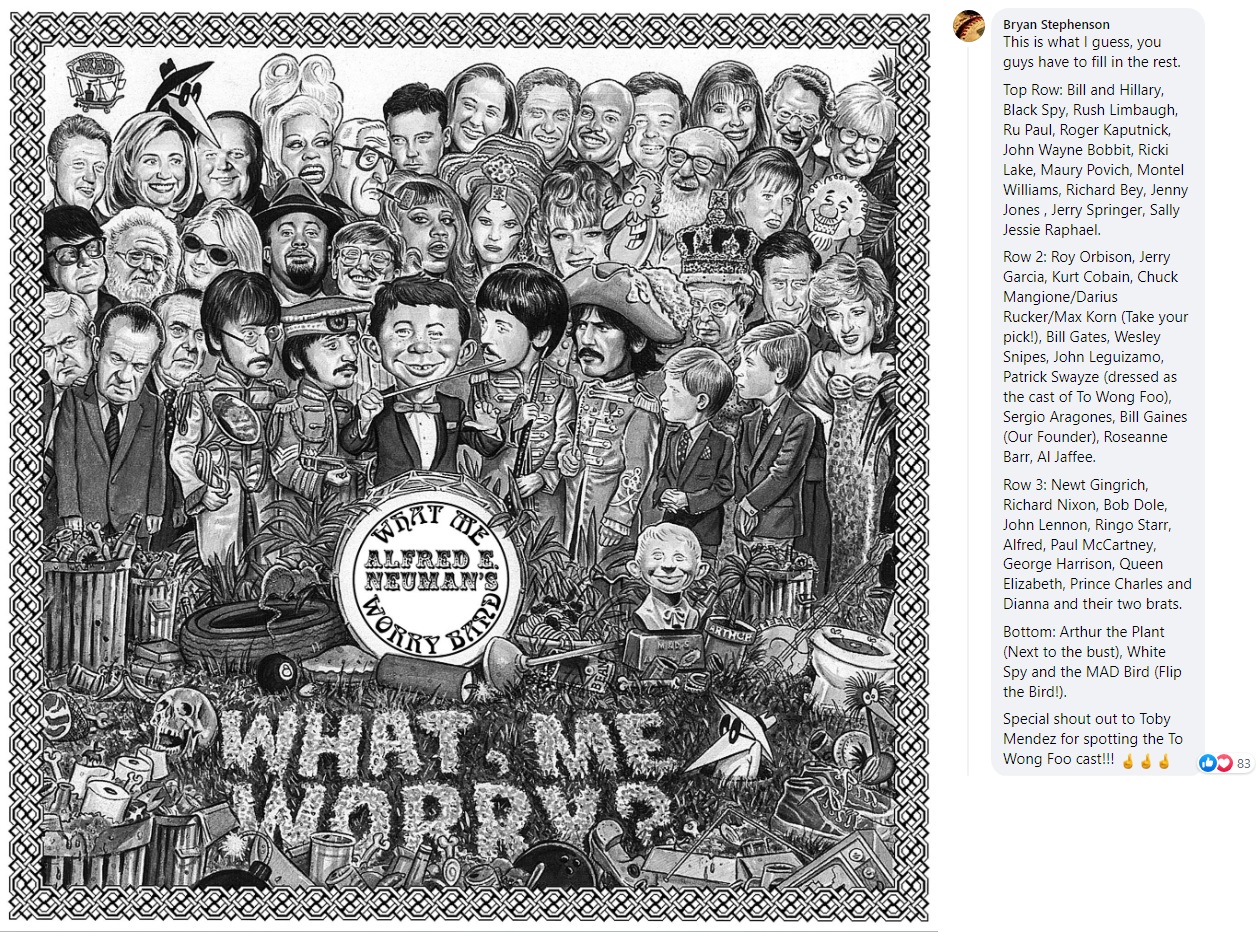 |
 |
 |
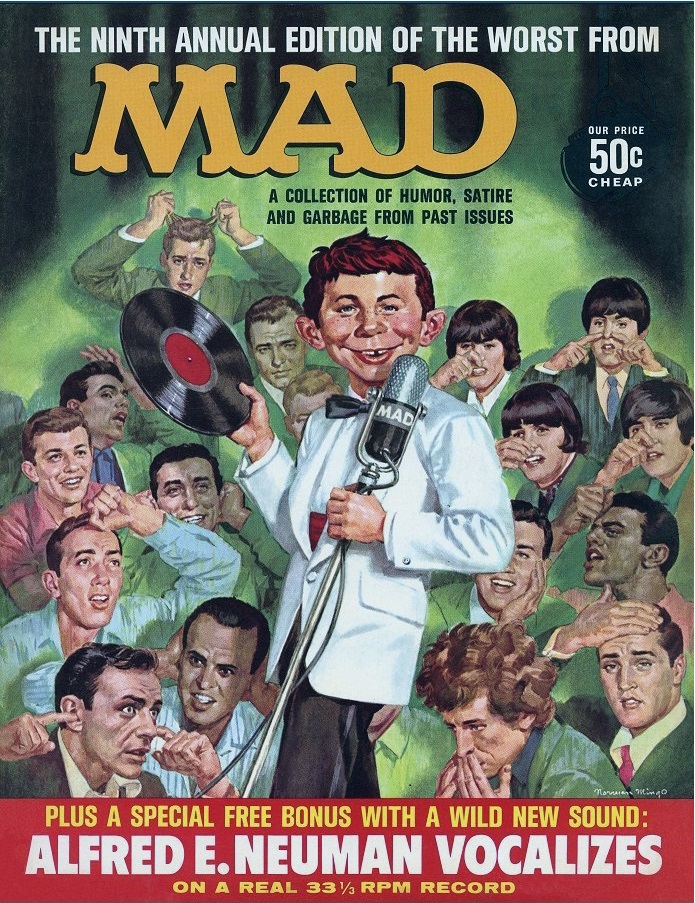 |
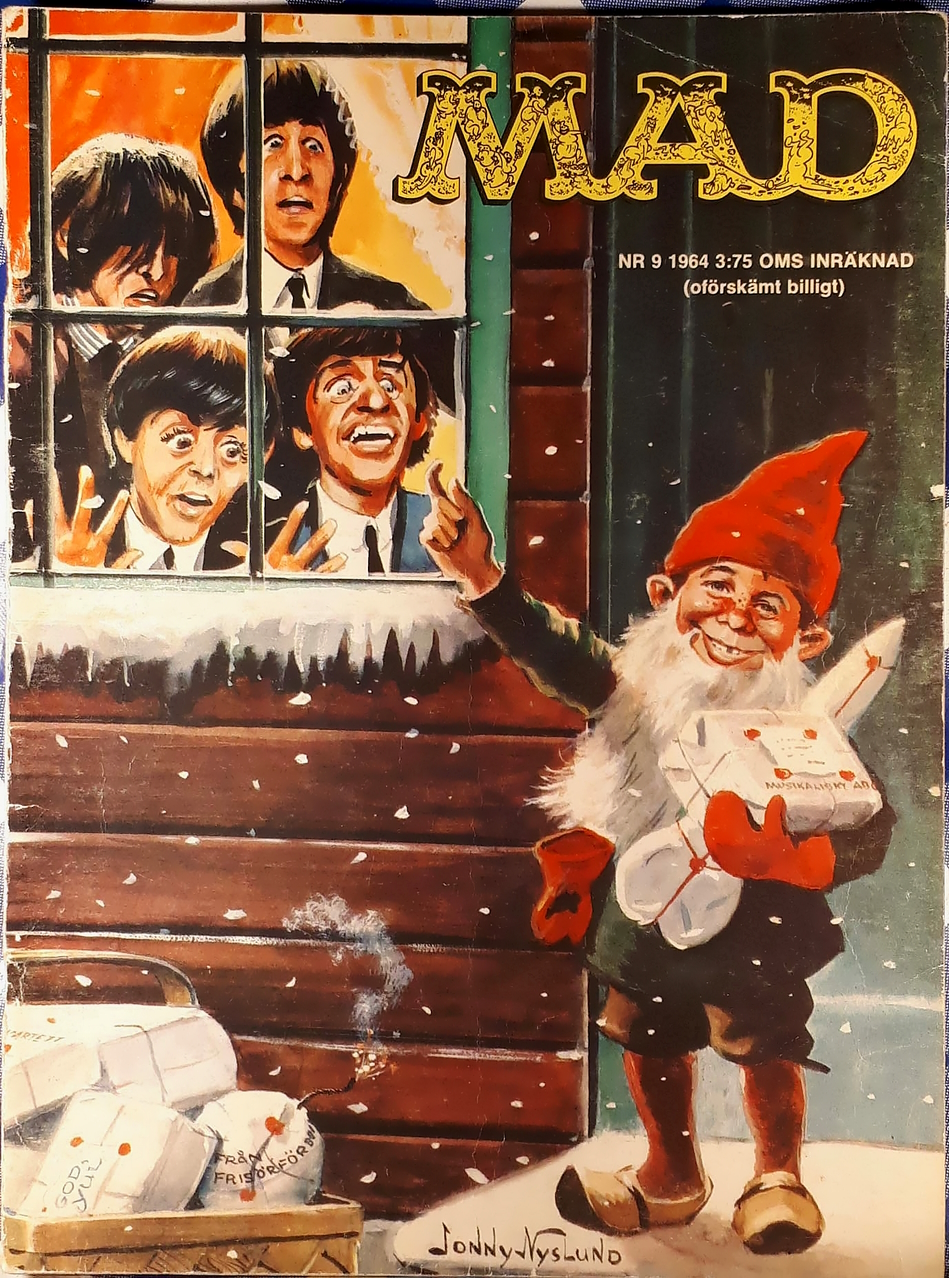 Mad Magazine from Sweden, 1964. |

June 12, 2023
Luna Lee performs "I Want To Hold Your
Hand" Gayageum version
The gayageum or kayagum (Korean: 가야금; Hanja: 伽倻琴) is a traditional Korean plucked zither with 12 strings, though some more recent variants have 18, 21 or 25 strings. It is probably the best known traditional Korean musical instrument. It is similar with other Asian instruments like Chinese guzheng, Japanese koto, Mongolian yatga, Vietnamese đàn tranh, Sundanese kacapi and Kazakh jetigen.
Pete Best performs "Cry For A Shadow"
An instrumental song by The Beatles composed by George Harrison and John Lennon, recorded in Hamburg in 1961 by John Lennon, Paul McCartney, George Harrison and with
Pete Best on drums. This version was made in February 2017 to open the participation of our special guest, Pete Best, in our show at the Municipal Theater of Fernando de la
Mora.

June 11, 2023
Beatles Scrapbooks Secrets
| NEW SERIES | Episode 1: June 1963
by Andrew from Parlogram Auctions
 |
Will It Go Round In Circles - By Billy Preston and Eric Clapton
An outstanding performance from Billy Preston and Eric Clapton. From "One More Car, One More Rider" is the eighth live album by Eric Clapton, released on 5 November 2002 on
Duck / Reprise Records. It
is also his third double live album. The
album contains songs performed during
Clapton's 2001 world tour.

June 10, 2023
Paul McCartney’s New Book Features
Never-Before-Seen Photos From 1960s
‘Beatlemania
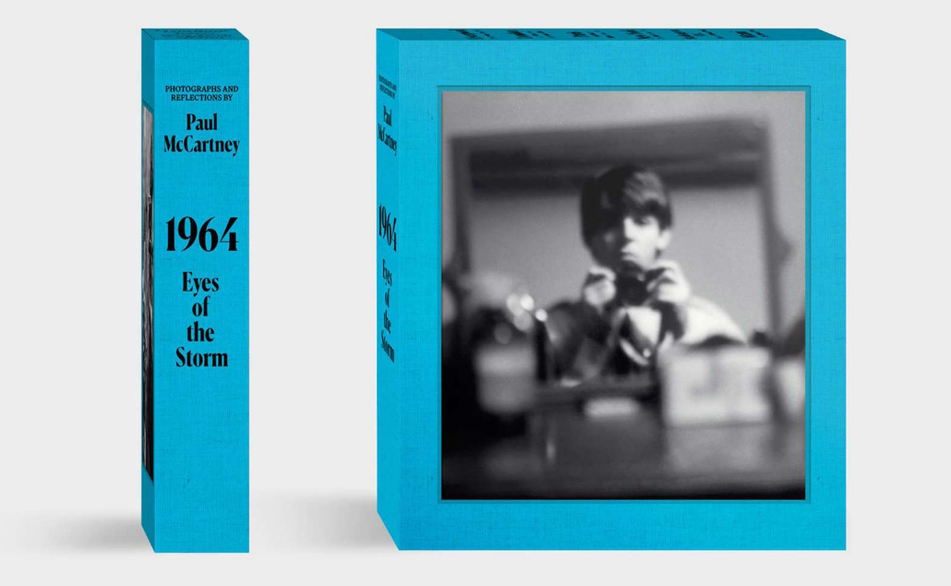 |
Throughout the explosive period in the early 1960s when the Beatles rose to unprecedented fame with hits like “Please Please Me,” “From Me to You” and “She Loves You,” Paul McCartney was quietly snapping shots on his 35mm camera to commemorate the moments that we now know would change music history forever.
These largely unseen photos are now featured in a new book by McCartney himself, alongside historian Jill Lepore. “1964: Eyes of the Storm” includes more than 274 images from the legendary months between 1963 and 1964, when the Beatles became an international sensation and performed in Liverpool, London, Paris, New York, Miami and Washington D.C, where they induced near-hysteria and deity-like worship among fans.
In a personal forward written by McCartney, he recalls the pandemonium of British concert halls, followed by the hysteria that greeted the band on its first American visit: “Millions of eyes were suddenly upon us, creating a picture I will never forget,” he writes.
McCartney’s candid recollections precede each city portfolio, coming together to create an autobiographical account of the period that he refers to as the “Eyes of the Storm,” plus a coda with subsequent events from 1964.
Also included in the hefty tome is Lepore’s essay “Beatleland,” in which she describes how The Beatles became the first truly global mass phenomenon.
“You could hold your camera up to the world, in 1964. But what madness would you capture, what beauty, what joy, what fury?” she writes.
The book is currently available to pre-order on Amazon and Barnes & Noble, which is offering the chance to win a signed, limited-deluxe edition with every pre-order. The sweepstakes ends June 12.
Pre-order “1964: Eyes of the Storm” below:
 |
Related link with lots of photos and comments from Paul: ‘Suddenly, we were in Wonderland’: Paul McCartney on his lost photos of Beatlemania by The Guardian

June 9, 2023
The Beatles Probably Wouldn’t Exist
Without This Movie
by Kelcie Mattson, features writer for Colider
 |
In the age of concert videos so high-definition you can see individual beads of sweat, nothing seems especially unique about The Girl Can't Help It. Billed as "blonde bombshell" Jayne Mansfield's first starring role, the 1956 musical-comedy features a string of rock and roll icons performing their hearts out in vivid, widescreen technicolor. It's a delight for modern audiences to see Little Richard, Fats Domino, Eddie Cochran, Gene Vincent, The Platters, and Abbey Lincoln in one place, but nothing revolutionary when we have YouTube at our fingertips.
For 1950s audiences, however, The Girl Can't Help It was a literal cultural reset. Since full-length concert movies didn't exist and Elvis Presley had just one film credit under his belt, this otherwise mediocre comedy was the only way rock and roll fans could see their idols in the flesh. The disembodied voices emerging from a record player suddenly had faces rendered in loving cinematic close-up, their physical mannerisms radiating charisma as dynamic as their volcanic vocals. The Girl calls itself "a story about music," and although the plot satirizes the industry, it's also a celebration of rock and roll so visceral it metaphorically brings down the house. It's a film so powerful, it birthed The Beatles. But, how?
 |
What Is ‘The Girl Can’t Help It’ About?
From a structural standpoint, The Girl Can't Help It qualifies as two different movies shoved together. It's 50% a comedy and 50% a musical montage, and the two never overlap. The comedic narrative follows Jayne Mansfield's Jerri Jordan, a socialite whose mobster boyfriend Marty "Fats" Murdock (Edmond O'Brien) schemes to make her a famous musician. The trouble is, Jerri can't sing for love or money. Murdock, wielder of the world's most exaggerated New York accent, doesn't care. He hires down-on-his-luck talent scout Tom Miller (Tom Ewell) to manage Jerri's career on the condition Tom doesn't get romantically entangled with Jerri. Hands off the mobster's girl, or there'll be consequences! Tom, for his part, is an alcoholic grieving his career lows and a failed romance. Tom and Jerri (insert joke here) break the rules by catching feelings, but not before endless jokes about Jerri's sex appeal. (More on that later.)
Then, there's the musical half. Most musicals of the 1950s were MGM-produced gold standards like My Fair Lady and The Sound of Music. The characters sang their way through the story and were played, or dubbed, by qualified singers. The Girl distinguishes itself from tradition by letting established musicians handle the performances while the actors stay in their lane. The numbers take place in nightclubs with lavish backdrops and meticulous cinematography while Jerri and Tom watch. Jerri doesn't take to the stage until the second-to-last scene. Keeping the qualified musicians separate from the musically disinclined actors is an interesting choice and highlights each singer's overwhelming talent. The Girl's plot could exist without these performances, but it would be a far lesser film for it.
So, how do icons as giant and influential as The Beatles come into play? Well, John Lennon was sixteen years old when The Girl Can't Help It reached Liverpool, England in the summer of 1957. Like every famous artist, Lennon was a fan first and a musician second. He worshiped the likes of Little Richard and Fats Domino. Seeing them as living, breathing figures in The Girl inspired Lennon to follow his musicianship dreams and form The Quarrymen, a rock group consisting of Lennon and his classmates.
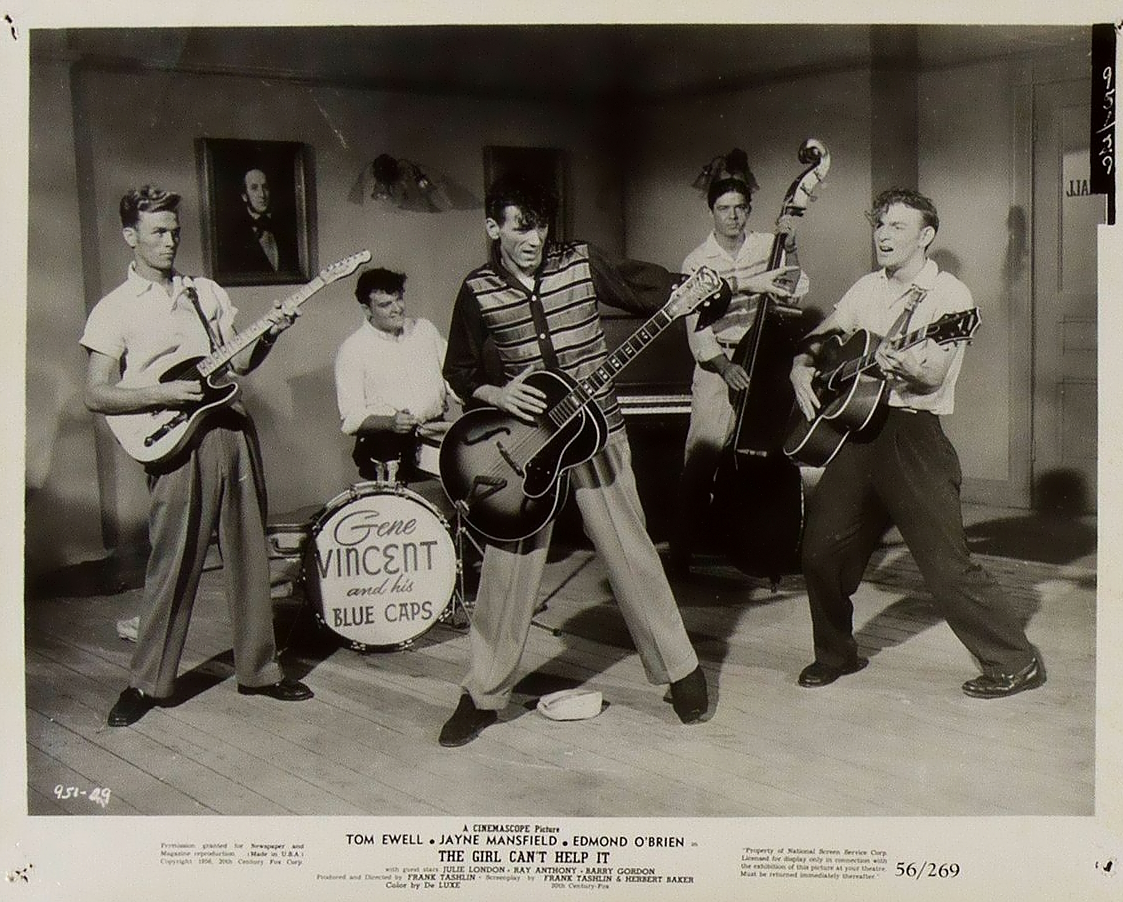 |
Lennon wasn't the only future member of The Beatles who was captivated by the film's music. When a youthful Paul McCartney auditioned for The Quarrymen, he imitated Eddie Cochran’s rhythm guitar technique on "Twenty Flight Rock," a song written for the film. Suitably impressed, Lennon recruited McCartney. History was made, and The Quarrymen later evolved into The Beatles, a little band you might have heard about who rewrote the rules of the music industry.
Focusing on Musicians Makes ‘The Girl Can’t Help It’ Unique
Next question: what made The Girl such an electrifying experience for these Liverpudlian kids? Writer-director Frank Tashlin milks the widescreen Cinemascope aspect ratio for all it's worth. He uses long takes, slow tracking shots, and close-ups throughout the film's musical numbers. Each performance lasts the length of the song with the singers maintaining maximum eye contact with the camera, and there are few interruptions. Tashlin either revered the musicians or wanted to give them their proper due. Either way, his intentionality lets the singers burn up the screen with these showstopping musical numbers. Little Richard's first onscreen performance is the definition of fire, while Abbey Lincoln's passionate magnetism pours off the celluloid. Tashlin doesn't get overtly flashy with fancy camerawork or frenzied editing; he lets the music sing for itself, and that makes all the difference.
Moreover, Black musicians created rhythm-and-blues, which evolved into rock and roll, which white culture then appropriated. At least half of The Girl's featured artists are Black pioneers of the genre. One socially dated film from 1956 isn't some magic solution to racism and capitalist inequality, but The Girl immortalizes unshakable onscreen proof that Black singers invented and defined what we know colloquially as rock music.
As for The Beatles, the four worshiped Little Richard and emulated his chord progressions. But their career might have been quite different if they hadn't opened for Richard on his 1962 tour. Richard even coached McCartney's developing vocals. In McCartney's words, "We [idolized] these people and we always thought they were given crummy treatment - until The Girl Can't Help It."
The Girl also doesn't unfairly posit that enraptured teenager fans are "juvenile delinquents." Rock was popular enough to make a movie capitalizing on its success, but a group of very loud adults scandalized by Elvis's dance moves was still convinced the genre was evil, and they stereotyped its fanbase. The Girl Can't Help It embraces rock and roll's natural energy, including the sexual undertones (or overtones), but doesn't layer an agenda over it. The music just is.
1950s Sexism Strikes Again
Circling back to that plot — Mansfield was undoubtedly beautiful, but the cringe-inducing gags are predicated solely upon Jerri's exaggerated good looks. Do we really need a montage of her sashaying down the street while men exhibit ludicrous, slapstick-level reactions? Likewise, Tom parades her throughout the clubs and men ogle her in droves. Jerri receives contract offers aplenty, so the jokes are on those creeps, but the tired "hot woman very wow" routine is browbeaten into the floor. Other films objectify women in far more insidious ways, and so The Girl's humor needn't be taken as malicious. It still raises the age-old difference between appreciation and exploitation, however.
To the film's credit, Jerri sneaks past the dumb blonde caricature in surprising ways. Her breathy, soft voice is an affectation, and she's under no illusions about her relationship with Murdock. She feels she owes the older man for his past kindnesses. Jerri doesn't seem disturbed by this fact, just resigned, but neither is she oblivious to its connotations. Jayne Mansfield wanted roles that didn't reduce her to a sex symbol but couldn't escape the box Hollywood put her in, which makes The Girl's vapid material extra smart.
Overall, Jerri has plenty of interiority. The other glaring problem is the fact she doesn't want a career. Jerri longs to be a homemaker complete with the whole shebang of a husband and kids, and it's actually Murdock chasing fame by proxy. Jerri's sad others view her as a "sexpot" and therefore ill-suited to motherhood, which is a load of malarkey the film actually calls out when Jerri gets her happy domestic ending. She chooses what she wants, and what she wants isn't wrong, but it also feels suspicious for the plot of a 1950s movie to revolve around a woman resisting a career in favor of being a home-focused caretaker
Art Inspires New Art
The film's impact didn't stop there with The Beatles. Little Richard, Fats Domino, and Eddie Cochran also inspired rock giants Led Zeppelin. Their concert film The Song Remains the Same owes its existence to The Girl, while Paul McCartney shared an anecdote that all four Beatles rushed through composing their song "Birthday" so they could go home and watch The Girl Can’t Help It’s BBC premiere in 1968.
Media has no shortage of artists paying homage to their inspirations, but The Girl Can't Help It crystallizes the importance of art. Something as small as a summer day at the movie theater can set off a chain reaction resulting in bands that revolutionized the music industry. Without access to art that inspires us, countless creatives might never have pursued their dreams — and the world would be lesser for it. The Girl Can't Help It's thesis statement is true: it's a story about music, but also one about love, marriage, and family...and sadly sexism.
 |
ABOUT KELCIE MATTSON Kelcie Mattson is just a small-town girl and a senior features writer for Collider. She's also had the pleasure of contributing to Bright Wall/Dark Room and IndieWire. Having grown up on Star Trek and TCM marathons, becoming a nerd for many things was inevitable. Her favorite pastimes include baking, petting her cat, reading very long books, and talking your ear off about sci-fi, fantasy, Dragon Age, Hammer Horror movies, British procedurals, and K-Dramas. |

June 8, 2023
Mach Show
 |
 |
 |

June 7, 2023
The Beatles In New York
by Bernice Young for
 |
 |
 |
Listen to a forgotten interview with The Beatles recorded at Huddersfield’s ABC cinema in 1963 – and there’s an incredible gallery of images of 1960s stars
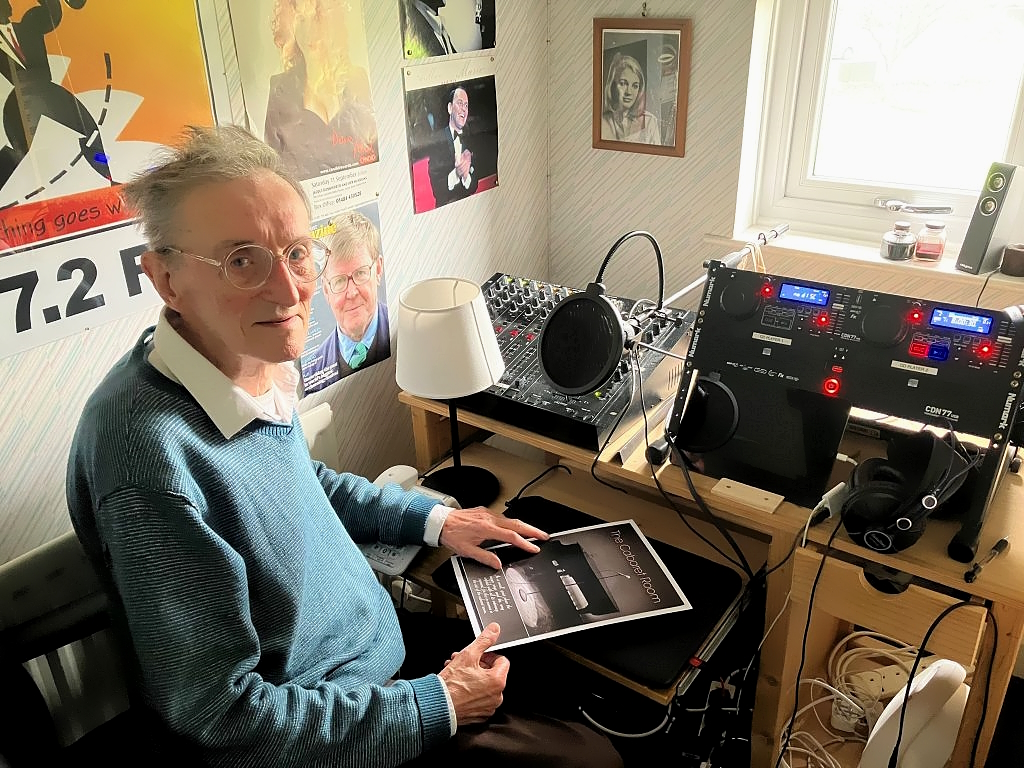 Laurie Stead at his home studio in Grange Moor He’s interviewed The Beatles, The Rolling Stones and The Hollies in Huddersfield and even had Dusty Springfield round for tea.
And now you can listen to Huddersfield music journalist Laurie Stead’s interview with The Beatles from 60 years ago.
This year is the Kirklees Year of Music and, as part of that, 12 podcasts called TOWNSOUNDS have been released which explore Kirklees’ rich musical heritage.
They are hosted by community songwriter and historian Sam Hodgson and uncover previously untold stories through interviews with local musicians. The music ranges from folk and choral to Bhangra.
In the episode called Roll the Rock Home: 70 years of rock and roll in Kirklees, Sam uncovers the little-told story of the Kirklees rock and roll scene in the 50s, 60s and 70s and features The Beatles interview clip recorded by Laurie and not heard for decades.
But how did Laurie manage to organise the interview with the Fab Four on his home Huddersfield stomping ground?
In the late 1950s a very young Laurie Stead joined hospital radio in Huddersfield when the station broadcast to 14 hospitals and welfare homes including one just for blind people.
Within a few years he was interviewing some of music’s biggest stars because at that time Huddersfield was well and truly on the music circuit with both The Beatles and The Rolling Stones playing the ABC cinema in the town centre along with a host of other stars he met.
These included The Hollies, The Animals, Dionne Warwick, Cat Stevens, Gene Pitney, Joan Baez, Del Shannon, Gerry and The Pacemakers, Freddie and the Dreamers, Helen Shapiro, Elkie Brooks and Ken Dodd.
The ABC cinema was regularly transformed into a live music venue as was the Tudor Cinema on Zetland Street which was later renamed the Essoldo.
Laurie was big friends with Gorden Kaye who later became one of the best-known faces on British TV in sitcoms such as Allo Allo, Are You Being Served?, Porridge, Minder and Coronation Street.
Laurie, of Grange Moor, said: “Life was very different back then and we learned as we went along although, in our case, it was while speaking to some of the massive stars of the day. The first one we did was Billy Fury.
“The Beatles were right at their peak when they came to the ABC and, like everywhere else, you couldn’t hear them playing for the girls screaming.”
Usually there were four local lads who did the interviews – Laurie, Gorden, photographer Brian Lawton who was a postman during the day and someone from Huddersfield Tape Recording Society so they could actually record it for the radio. This was usually David Whiteley who later became Head of Sound at Yorkshire TV.
The quartet normally got backstage at all the gigs without a problem although Laurie suspected The Beatles one might be different so wrote to their manager, Brian Epstein, who replied, saying: “I have made a note to advise the group that they will be involved in an interview on that day.”
And they honoured it although only Gorden and Laurie were allowed backstage from his gang of four.
John, Paul, Ringo and George answered his questions, but had knockabout fun doing it.
When Gorden said he understood they’d all met on the upstairs of buses, Ringo said it must have been downstairs as it was too tiring for him to climb the stairs. John said the Huddersfield show was “one of the best receptions we’ve had.”
When asked what his favourite film was he said it was the 1962 film The Trial directed by Orson Welles about an unassuming office worker who is arrested and stands trial but is never told what crime he’s accused of committing.
He said he loved listening to American groups and if he could go anywhere without being followed by screaming hordes of fans where would he go?
“I’d go to see my dad,” said John. “He’s still in Liverpool and he’s a good lad.”
Gorden even asked the Beatles what they’d do when all the euphoria ended and their music career was over, thinking it would only last a few years.
George, who revealed he read Tolstoy in his spare time, said his ultimate ambition was to join the Royal Navy and be a Lieutenant Commander on the HMS Queen Victoria. He claimed his favourite place to visit was Hull and he loved traditional jazz, especially Kenny Ball.
When asked if he thought fans were paying too much for their tickets, George replied: “Only those they buy on the black market. I don’t like them as they’re making money which should be ours.”
One of the band members then claimed: “George is going solo” before another hit back with “so low we can’t see him.”
Ringo – apparently so named because of all the rings he wore – quipped: “I’ve never bought a ring in my life. They’re all presents.”
Days before the show fans queued all night to buy tickets with some willing to pay the top price of 10 shillings and sixpence.
When Laurie asked one girl what she’d do if she met The Beatles, she replied: “I’d talk to them, then I’d faint.”
Huddersfield Round Table and Huddersfield Ladies Circle turned up in a van to serve 1,786 cups of Bovril to keep the queuing crowds warm.
Dusty Springfield played Huddersfield on a Wednesday but the only problem was the town shut down at 1pm as it was half-day closing.
She was peckish and wanted a cup of tea so Laurie took her to his parents’ – James and Kathleen – home on Zetland Street in the town centre, chased by loads of kids desperate for her autograph.
“She even took her shoes off before she went inside, “ said Laurie. “Mum then made her a sandwich and a cup of tea and Dusty spotted I had the latest Joan Baez album and asked me to play a track from it. She was lovely.”
By this time there was a huge crowd outside the house but the Steads lived next to the Irish League Club so they took Dusty through the club and Huddersfield Polytechnic students formed a guard of honour from the club across the street to the Tudor where she was playing so she could get there safely.
Laurie did an interview with The Rolling Stones in around 1963 which was recorded on acetape but is now very fragile and he’s not been able to afford to get it transferred onto compact disc.
Laurie, who was jazz correspondent at The Huddersfield Examiner for many years, loves cabaret music, especially the cabaret scenes in the USA and London. He does a monthly podcast called The Cabaret Room where people will hear singers they’ll have never heard before.
Each podcast is 50 minutes and you can hear it on Laurie’s website The Cabaret Room (https://www.thecabaretroom.co.uk/), Apple Podcasts or the Amazon-owned Audible platform.
For more about the TOWNSOUNDS project and to listen to the interview with The Beatles go to https://www.musicinkirklees.co.uk/en-UK/topic/63bef44790a31c514f73cf5f and scroll down to Episode 3.
|

June 6, 2023
The Crazy Story of the Magical
Mystery Tour LP - The Beatles BEST
Capitol Album?
Unhappy with the thought of releasing the next Beatles album as a 2-EP set, Capitol Records put together one of their finest creations, the Magical Mystery Tour LP. Despite its unique mixes and superb packaging, its sound quality left a lot to be desired. Capitol's failure to secure the correct stereo mastertapes led in the 1970s and '80s to some of the worst sounding official Beatles pressings ever made. In this video, we'll tell you all about that and what is the best way to hear it today.
 |
 |

June 5, 2023
Masterful Remixer Giles Martin On The Beach Boys' 'Pet Sounds,' The Beatles, Paul McCartney
precious album.
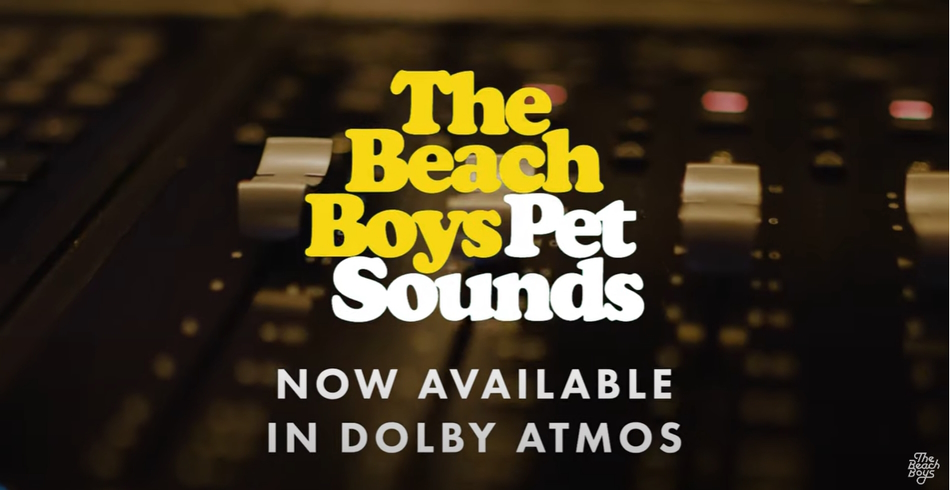 Bicycle bells, Coca-Cola cans, sleigh bells, water bottles, French horn, Electro-Theremin — and that's just the tip of the iceberg.Compared to even ambitious Beatles masterpieces like Revolver and Sgt. Pepper's, remixing the Beach Boys' Pet Sounds is an entirely different beast. While the Fabs' recordings were often deceptively sparse — "Taxman" is guitars, bass, drums and vocals — Pet Sounds is an ocean of eccentric, melancholic, joyful sound.Astonishingly — by today's standards — the album was initially recorded to a four-track machine. A student of the studio might assume that remixing the such a record would require some form of sacrifice during the remixing process, wherein various elements would have to be buried, or excised, to bring another to the light.Giles Martin, who has remixed Sgt. Pepper's, The White Album, Abbey Road, Let It Be, and Revolver — and now Pet Sounds, for Dolby Atmos — has an incisive answer."Will I sacrifice taste or feel for the sake of it being an Atmos mix? If that starts getting compromised, then let's make it mono," two-time GRAMMY winner Martin tells GRAMMY.com. "It doesn't make any sense to affect the integrity of a song for the use of technology. Technology should be there to serve the music, as opposed to the other way around."I don't want people to listen to an Atmos mix I've done; I want people to listen to a song," he continues. "My mix is just a small part in the process."But sitting in complete darkness in a Dolby screening room on Sixth Avenue in New York City, it was difficult to think of Martin's touch as being a "small part."This version of Pet Sounds was nothing short of revelatory — shining up each Beach Boy's vocals, unburying numberless exotic instruments, mapping the musical elements in physical space. All without compromising Brian Wilson's timbral and harmonic syntheses that characterize this art-rock cornerstone.Read on for a candid interview with Martin about his remixing philosophy, moving from the Beatles space to the Beach Boys space and what he wants to improve about his methodology — in short, "everything."The Atmos mix of Pet Sounds is available now on Amazon Music, Tidal and Apple Music; stream it here. This interview has been edited for clarity. During Beatles listening events, there's a little bit of tension between yourself and that fan community. This Beach Boys event seemed to possess a completely different energy — less antagonistic, more of a lovefest. What's it been like moving from the Beatles world to the Beach Boys world as per their fan communities? I don't know — I think that I may not be perceiving it right [laughs].I never felt that there was a huge amount of antagonism with the Beatles thing. I think to begin with, there was. With the early days of me, certainly, doing Love, ironically, there was a suspicion of what I was up to — what are my motives, and what gives you the right to screw around with these tracks, and who the hell do you think you are, and that sort of thing.I think there's been a sort of shift in a level of trust, hopefully, that people don't realize that I deliberately do this to try and screw things up.I was actually more nervous going to a Beach Boys playback than I was going to a Beatles playback. With the Beatles, I kind of know where I am — and regardless of what anyone may think, I probably have more experience on this than most other people do.The Beach Boys, I don't. It's my first rodeo, if you like, so I was probably a bit more nervous addressing their audience. "Antagonism" is probably too strong a word. Just a little bit of tension in the air, when somebody's like, "What happened to that guitar squeak at 2:01 on 'Taxman,' Giles? Would you like to explain yourself?" That always makes me laugh. There are two guys who are those people, and they come and listen in the studios. They came around recently for something, and they were like, "Well, we heard something at this moment."I'll always listen and respect what they say, but then I'll just go… I do have Paul and Ringo. So they'll just go, "Well, we think it's fine."I think what you are alluding to is there's a sense of ownership that people have over Beatles music. But I think that's the case with Pet Sounds and the Beach Boys as well. From a business standpoint, what's it been like docking your spaceship on a new mothership? I pay no attention to the business side of stuff. It's the same record label, actually — Capitol. I have a really good relationship with them, and they're great.They know what they're getting themselves into by asking me to do stuff, which means that generally, things will be late; I'll miss deadlines. But they also know that I'll take care. And I think part of my job is, obviously, listening to what people have to say, and listening to and collaborating with other people on this, and doing it. What role did the Beach Boys and Pet Sounds play in your life up to this point? Obviously, you're steeped in this overall miasma due to your lineage. It's funny: as I said to my dad legendary Beatles producer [George Martin], "It's amazing the work you did." And he was like, "Yeah, but I mean, compared to what Brian Wilson did when he was just on his own — you need to go listen to that." And so I did, and I suppose that there's an otherworldliness to it.Just as a producer, or someone who loves music, Pet Sounds could not be ignored, because it's so intricate in the way it is, and it's an album that gets better the more you listen to it as well. And I hope that is sustainable in times of TikTok where people only have a short amount of time to pay anything attention.I suppose that I wouldn't have agreed to do it if it wasn't important to me.You have to give it your all; you have to spend a lot of time listening to this music. It's such an important and influential record — not just for other people, but for me as well.  You mentioned during the listening party that you didn't have to employ the same AI techniques to unglue the tracks as you did on Revolver. Can you elaborate? I wouldn't say it was unglued. If you imagine on, for instance, "That's Not Me," essentially, the band are kind of on three tracks a lot. So, they're stuck.And "That's Not Me" has drums, organ, tambourine on one track. So, I can't move the organ or tambourine away from the drums. They have to be on one side. And I have bass and lead guitar on another track, so bass and guitar are going to be in the same place no matter what I do.But there's an intent with this, where it's unlike having a band like the Beatles. This isn't really a band record; it's more of an orchestral record. It has a backing to it.There's not really a drum kit on Pet Sounds, per se. There's drums on one or two tracks, but there's not really a drum kit. It's like orchestral percussion. So it's fine having those things glued together. Whereas on something like "Taxman," we have guitar, bass and drums — and only guitar, bass and drums going on for the whole song.If you want to have a stereo record, you have to separate them — because otherwise, they're just on one side and the vocals on the other side; there's no reality. But with this, you have chunks of musicians in a room, and then you can create this real world around it. Brian Wilson rightfully soaks up the lion's share of the discourse around Pet Sounds; he crafted the record. But in this process, what did you learn about them as per their group dynamic? You alluded to their vocal precision during the listening event. I love Carl and Bruce's vocals on "God Only Knows." I know that Carl and Dennis played on the record in a limited capacity. I don't know what I learned that I didn't already know, apart from the fact that — this is what people miss — bands exist with resentment, and everything else. But bands exist because they're human beings in a room. The fact that you don't hear someone doesn't mean that they're not having influence.With the Beach Boys, obviously, you hear their incredible harmonies. And Brian couldn't have done what he did without having the palette of outstanding musicianship, and the ability for these guys to harmonize and create these vocals that can't exist anywhere else.So, that's what I suppose you hear. You hear the other members of the band come in on tracks, as you alluded to, and you suddenly think — not that it's a relief, but it's like, Oh my god, this is a band. This isn't just Brian. That's what I took from it. I could genuinely sit there and think about the Beach Boys on a conceptual level and be entertained for hours. But is there a danger of overthinking an artifact like Pet Sounds? Or is it a fount for infinite analysis and edification? No, I think you are absolutely right. You can take the fun out of it — and people do frequently — by being too pretentious about things. I find this quite amusing. It's almost like the song becomes the ownership of the journalist — or the expert, if you like — and not the person listening to it.People are told what to listen to, and what to listen out for, in a sort of educational way: "You don't really understand this." It's that sort of thing: "If only you knew you knew how good this was, you'd be able to like it." That sort of conversation. "Music isn't like how it used to be, because it's not as good as this," and all this sort of conversation.It's absolutely rubbish. It's like, let people enjoy what they want to enjoy. As long as you're passionate about something, it doesn't make a difference whether you like Megadeth or the Beach Boys. You recently worked on a refreshed version of Paul McCartney's "Live or Let Die." That song is such a mind movie — and not just because it has James Bond roots. I'm sure you had fun with that one. It was great. It's a bit like a lot of the projects I do; the expectancy is so vast spread.It's quite tricky; how do you meet the expectation? Because one thing that mono or stereo or compression gives you, is it gives you loudness. You separate stuff in an immersive soundfield, you have to be careful that you don't start losing impact.One thing that "Live and Let Die" has is impact. And that's the tricky thing about that song. But I'm really happy. It was actually a big mix to do; I can't lie. It was like, "Oh my god, here we go; I have to be fully qualified to do this mix."But I'm really happy with it. I can't wait for people to hear it. I think it's super cool. How do you want to get better at what you do? Where do you want to improve?Oh, god. "Everywhere" is the answer. I think you are never done. It's only sometimes I hear things back and go, Oh, that actually sounds quite good. Oh, I did that. That's alright. Otherwise, you sort of hate everything.I nervously watched you [all] through a screen in New York going, Oh my god, it sounds terrible. That's what goes through my head. You still struggle with that, huh? Yeah, of course. And then the thing is, I don't think, What if it sounds terrible? because of ego. It's, What if it sounds terrible because you guys really like this record and I need to do it justice? That's what goes through my head. |

June 4, 2023
A 1968 publication of Rocky Raccoon
 |
A very rare artistic cover of Rocky
Raccoon. Not sure about the story
behind the publication,
but it sure
is nifty looking in terms of
artwork. Thought I'd post it for
Beatles fans. −− John Whelan, Ottawa Beatles Site |
Ringo In Nashville With The Beatles' Nashville Cat
by Frank Simpson for Hit Parader 1971 Yearbook
 |
 |
 |
Pete Drake,
George Harrison, Ringo Starr, Billy
Preston, and Peter Frampton during
the 'All Things Must Pass' sessions,
1970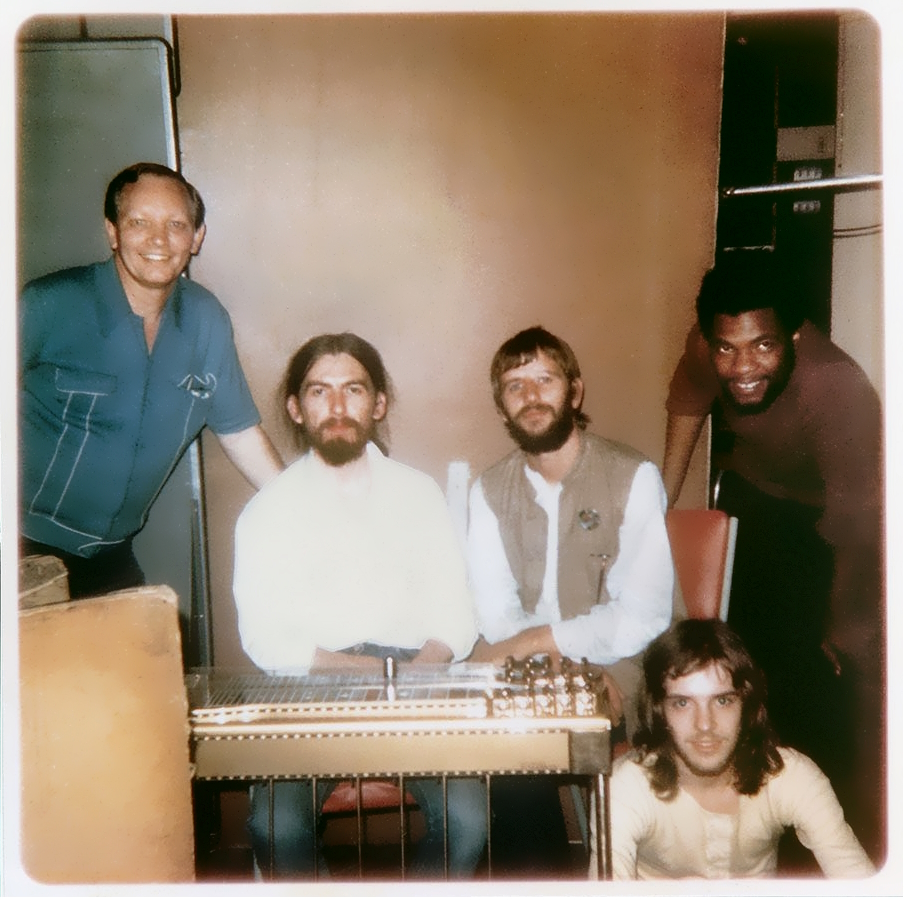 |

June 3, 2023
Paul McCartney’s 007 Theme ‘Live And Let Die’ Gets Dolby Atmos Mix
The new mix mark the 50th anniversary of the single from the film score of the same name.
by Paul Saxton for Udiscovermusic.com
Paul McCartney’s 1973 James Bond movie soundtrack theme “Live and Let Die” has been remixed in Dolby Atmos by Giles Martin – son of the track’s original producer, George – and Steve Orchard. The new mix mark the 50th anniversary of the single from the film score of the same name, which was produced in full by George Martin.
The new, immersive mix allows fans to hear “Live and Let Die” in a completely new way that puts the listener right at the heart of the track. The song has continued to reach new audiences as a central feature in McCartney’s live shows, including his headlining appearance at Glastonbury Festival last year, marking his 80th birthday.
Paul was commissioned to write the theme song in 1972, overcoming his initial doubts that the piece he came up with might not stand comparison with the likes of ”Goldfinger,” “From Russia With Love,” and “Diamonds Are Forever.” His worries were unfounded: it became the first Bond theme to receive an Academy Award nomination for Best Original Song, and went on to win a Grammy Award in 1974.
I
n a January 1974 edition of Rolling Stone, McCartney spoke about the number of offers he received to do such projects. “I get quite a few, you know,” he said. “I just try and choose the ones I like the sound of. It’s not anything I plan out.
“I remember a thing in Rolling Stone — there’s a little bit of chat, I read the papers, you know — that said ‘McCartney’s going to do Live and Let Die, so it’s come to that, has it?’ I thought, you silly sods. Because we were talking to another paper and when I said I was going to do Live and Let Die, the 007 thing, the reporter said, ‘Hey, man, that’s real hip.’ So it just depends which way you look at it.”
'I’ve got a song for a film'
George Martin, in Stuart Grundy and John Tobler’s 1982 book The Record Producers, recalled: “It all started with Paul ringing me up and saying, ‘Look, I’ve got a song for a film. Would you produce it and arrange it for me?’ I said, ‘Sure,’ and spent some time with him at his house going through the thing, and from my point of view, we were making a record, so I didn’t spare any expense and booked a large orchestra.
“I said, ‘This is the way we’ll do it – we’ll do it with Wings, and work on the session with just the group, and then in the evening, I’ll bring in the orchestra, but we’ll still keep Wings there, and try to do it live altogether, to try to get a live feeling to it,’ and that was what we did, except that I found the pick up from the strings was too loud for Paul’s voice, so I took the strings outside and overdubbed them. Apart from that, it was a live recording, and then we put on backing voices, and made what I thought was a good record.”
− End of article
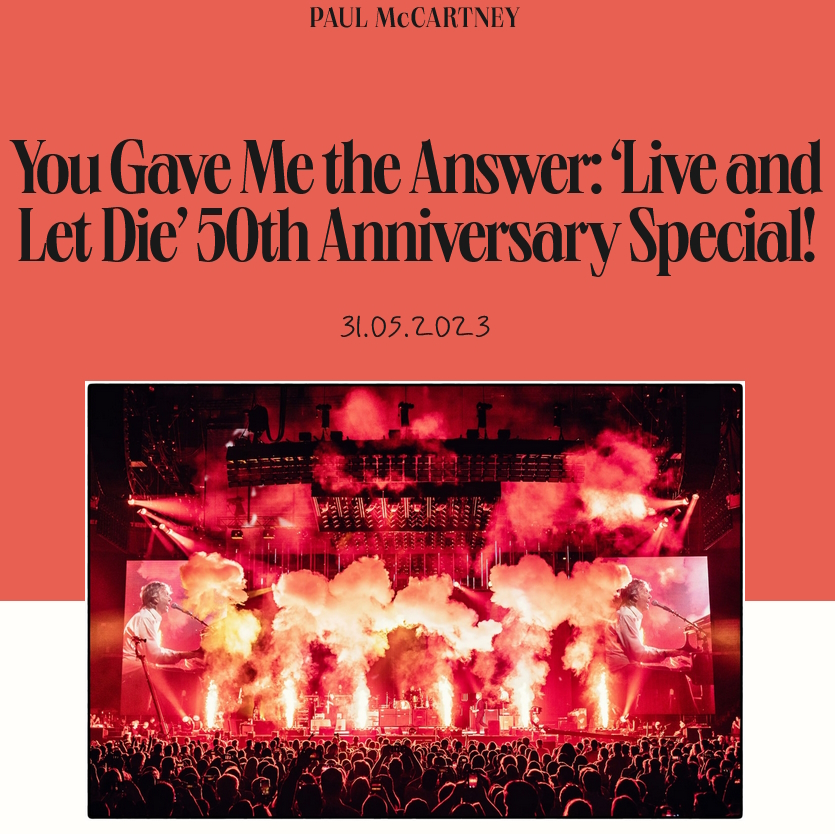 |
It started as a Bond theme, now it’s a legend: Wings’ 1973 song ‘Live and Let Die’ turns fifty this month!
In this ever-changing world in which we’re living, the song has been covered many times over the years – perhaps most notably by Guns N’ Roses in 1991 – and has been released on compilation albums such as Wings Greatest, All the Best!, Wingspan and Pure McCartney. More recently, it was included as part of Paul’s collection The 7” Singles Box, and this week sees its release in Dolby Atmos for the first time.
The track is also a staple of Paul’s live set, so if you’ve been to a show, chances are you’ve witnessed the crazy pyrotechnics that go off at the chorus and crank up the heat in every venue! It’s clearly still a favourite for Paul and the band to perform, so to mark this incredible milestone, we sat down with Paul and asked how he feels about ‘Live and Let Die’ today…
PaulMcCartney.com: Today, we’re celebrating fifty years of ‘Live and Let Die’. How do feel about the song fifty years after its release?
Paul: I don’t believe it, do you? I’m only forty-five! But no, it's always very weird when you get these kind of anniversaries because I don't keep count. I have no idea if it's coming up for fifty or sixty years or whatever. It’s shocking really, but in a nice way. I think, ‘Where did the time go?’ It’s nice that the song has lasted though, and people still enjoy it.
PM.com: Do you still think of it as a Bond song, or do you now associate it more with your live set?
Paul: I think it's a bit of bit of both. It felt like an important historical thing, writing a Bond song. The idea was suggested to me by Ron Cass, who was a guy who ran Apple Records at the time. He said, ‘Have you ever considered doing a Bond film?’ And I said, ‘Well, I would. But no one has asked!’. So, he spoke to the film’s producers, and then they came back and gave me the title ‘Live and Let Die’.
I went away and started thinking about that phrase. To me, obviously what happens is you think of the usual saying, ‘live and let live’. And then think about how you’re going to get to the opposite which is, ‘live and let die’. It was a little conundrum, but I enjoy those; it's like putting together a short story or something. I got the book the film was going to be based on, read it, and did the song the next day.
Ever since then, we’ve played it in our live shows, and we have these big pyrotechnic explosions that make people jump. Because of that, I now think of it as this big performance piece, and I do enjoy shocking people with the first bang! So, it’s definitely taken on a new meaning for me beyond the Bond film.
PM.com: Did you always know that the song would lend itself to the pyrotechnics in the live shows? Was this in your mind when you wrote the song?
Paul: No, not really. I thought it would just end up on the soundtrack of the film, as it did. But when we started performing it to big audiences, we got a bit creative and thought of all the explosions in Bond films. That’s what they’re all about! So, we got our pyrotechnics guy – who is amazingly called ‘Shaky’ – and together we worked it up. He did the explosions, and then we got our lighting guys to come in and add some sympathetic lighting to it, then our stage designer did the film that comes up behind us where we kind of blow up the Houses of Parliament and stuff like that. It all came together as a really nice moment in the show.
By adding these big explosions, you know it's going to make people jump out of their seat, and what we all love to do as a band is watch the front row. You can see the people who haven't been to the show before because it shocks them! If it’s a couple, they look at each other, and go, ‘Oh my God, did you see that?’ Which amuses us.
PM.com: Are there any particularly memorable performances of the song that you can remember?
Paul: Yes! In the early days of doing it with all the explosions, I remember this very old lady at the front. At a guess, I’d maybe say she was ninety or something. She was loving the show, and I'd started singing the opening lines of the song, ‘When you were young, and your heart was an open book…’ But then I looked at her and thought, ‘Oh God! We’re going to kill her! What do we do?’ I carried on and got to the crucial bit, ‘Say live and let die’ and... BOOM! The explosions went off. I sheepishly looked over, expecting the worst, and she was going, ‘Yeah!’ She was loving it! So, we didn't kill her; we thrilled her!
Forewarned is forearmed, so if you’re a bit jumpy (or ‘Shaky’!) – it’s probably best to sit a few rows back at Paul’s shows! We’re getting heart palpitations just thinking about it… And you can now hear the song clearer than ever, as ‘Live and Let Die’ is available to stream in Dolby Atmos on all supporting platforms
Got a question for Paul? You can ask via social media on Twitter or Instagram, or by posting in the Paul McCartney Official Fan Group on Facebook.
− End of interview
Beatles In India (part 2)
by Mal Evans for The Beatles Monthly Book
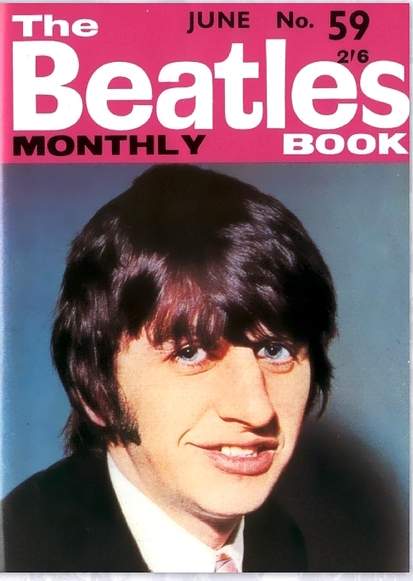 |
"Tomorrow Never Knows" -
Cover version by Monsoon / Sheila
Chandra -
Vinyl - at440mla (Dual Moving Magnet Cartridge) - Third Eye LP |
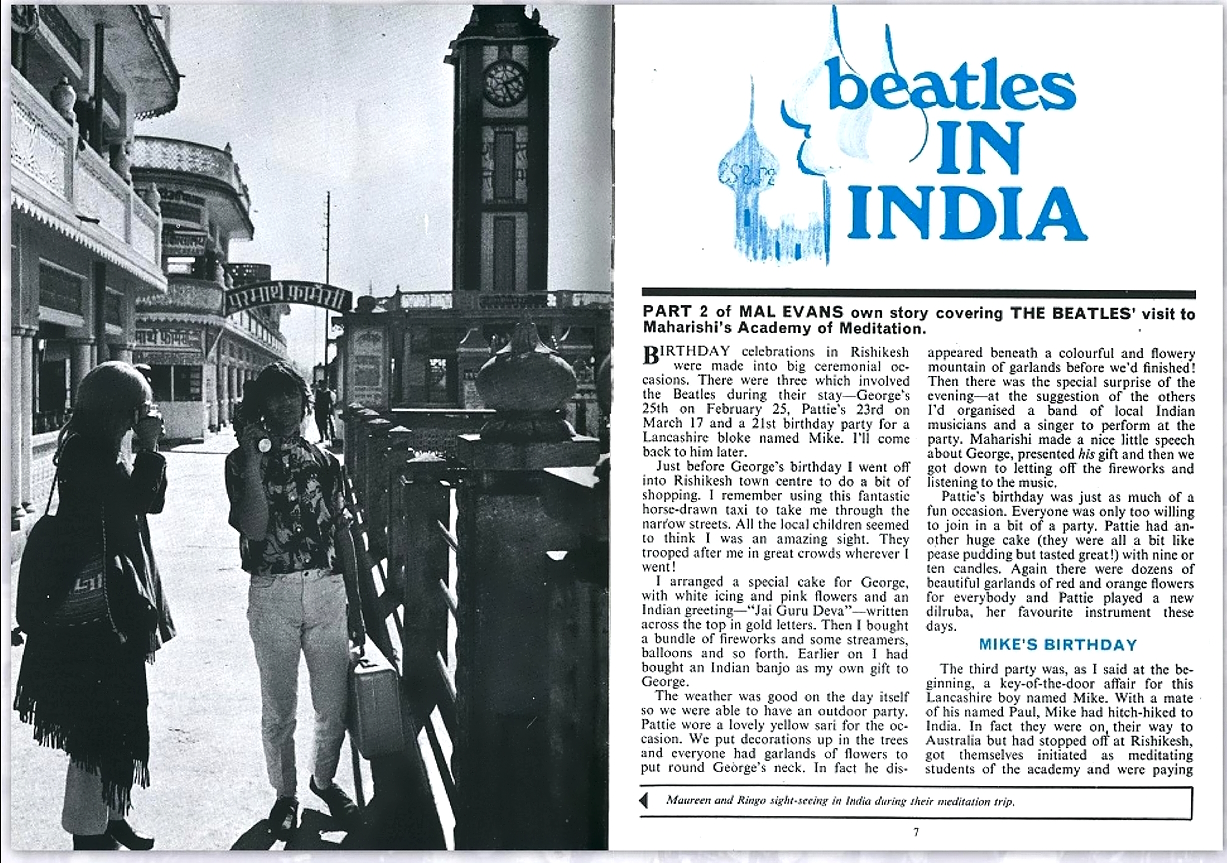 |
 |
 |

June 2, 2023
The Cool Brain behind the Bonfire
by Gail Cameron for Life magazine
 |
 |
 |
 |
by Peter Jones for Beatles Monthly
 |
 |
 |
| Ringo Starr performed on
Tuesday, May 30, 2023 in Prescott
Valley, Arizona (photos are from Ringo Starr and Beatles Facebook pages) 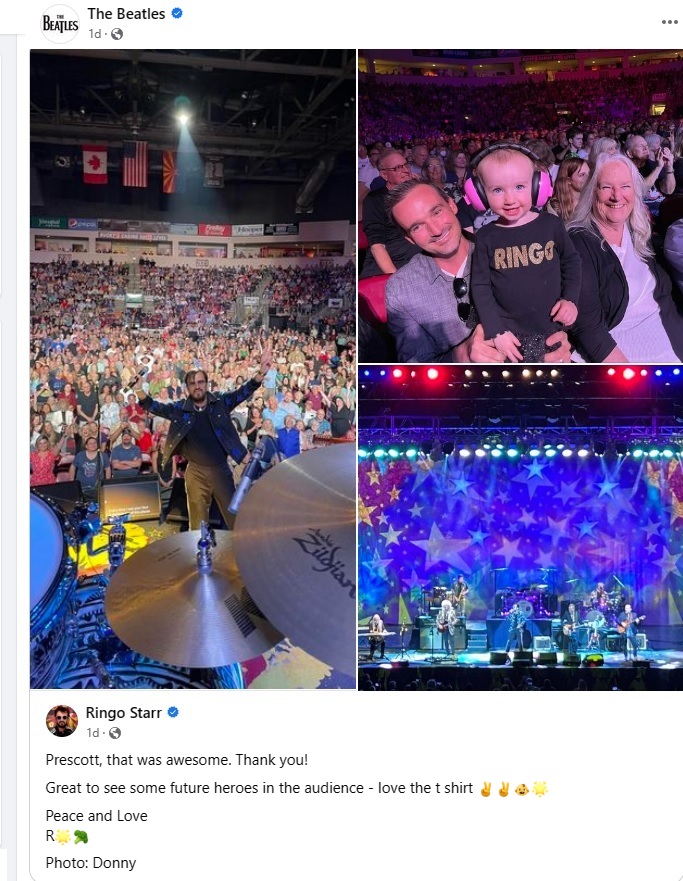 |

June 1, 2023
How DMM Changed The Sound of The Beatles + Pure Fidelity Stratos Cart Review
by Andrew from Polyrgram Auctions
By the late 1980s vinyl was doomed but German engineers came up with a mastering method they thought could compete with the sound quality of the soon to be launched CD, which was called DMM. In this video, we look at at how this worked and the effect it had on the sound of vinyl and demostrate it using a classic Beatles track. We also bring out a classic British vintage deck to test our a superb high-end MC cartridge.
Rubber Soul album review
by Scott Plagenhoef for Pitchfork
The Beatles' first undisputed masterpiece is their quietest and most folky record, reflecting the influences of contemporaries like Dylan and the Byrds.
 |
To modern ears, Rubber Soul and its pre-psychedelic era mix of 1960s pop, soul, and folk could seem tame, even quaint on a cursory listen. But it's arguably the most important artistic leap in the Beatles' career-- the signpost that signaled a shift away from Beatlemania and the heavy demands of teen pop, toward more introspective, adult subject matter. It's also the record that started them on their path toward the valuation of creating studio records over live performance. If nothing else, it's the record on which their desire for artistic rather than commercial ambition took center stage-- a radical idea at a time when the success of popular music was measured in sales and quantity rather than quality.
Above all, Bob Dylan's lyrical acumen and the Byrds' confident, jangly guitar were primary influences on John Lennon and George Harrison, respectively (and the Byrds had been influenced by the Beatles, too-- Roger McGuinn first picked up a Rickenbacker 12-string after seeing A Hard Day's Night). Dylan and the Byrds' fingerprints had been left on Help!-- Lennon, the group's biggest Dylan acolyte, played an acoustic rather than electric guitar throughout most of that record. Even Paul McCartney's "Yesterday" found him strumming an acoustic. (All this at a time when Dylan was beginning to move in the other direction and fully enter his electric period.) Harrison was growing more serious on the political "Think for Yourself", while "If I Needed Someone"-- his other contribution to Rubber Soul-- is practically a Byrds pastiche and his chiming, sure-footed solo on "Nowhere Man" also displays a debt to that band. His deft touch is all over the record in subtle ways-- appropriate for an album full of finesse and small wonders (the ping at the end of the "Nowhere Man" solo, Lennon's exhalation in the chorus of "Girl", the "tit-tit-tit" of the backing vocalists in the same song, the burbling guitar in "Michelle").
The most lasting influences of Dylan and the Byrds on the Beatles, however, were likely their roles in introducing the group to recreational drugs: Dylan shepherded the quartet through their first experience with pot, while the Byrds were with three-fourths of the Beatles when they first purposefully took LSD. (McCartney sat that one out, avoiding the drug for another year, while Harrison and Lennon had each had a previous accidental dosage.)
Marijuana's effect on the group is most heavily audible on Rubber Soul. (By the time of their next album, Revolver, three-fourths of the group had been turned on to LSD, and their music was headed somewhere else entirely.) With its patient pace and languid tones, Rubber Soul is an altogether much more mellow record than anything the Beatles had done before, or would do again. It's a fitting product from a quartet just beginning to explore their inner selves on record.
Lennon, in particular, continued his more introspective and often critical songwriting, penning songs of romance gone wrong or personal doubt and taking a major step forward as a lyricist. Besting his self-critical "I'm a Loser" with "Nowhere Man" was an accomplishment, and the faraway, dreamy "Girl" was arguably his most musically mature song to date. Lennon's strides were most evident, however, on "Norwegian Wood", an economical and ambiguous story-song highlighted by Harrison's first dabbling with the Indian sitar, and the mature, almost fatalistic heart-tug of "In My Life", which displayed a remarkably calm and peaceful attitude toward not only one's past and present, but their future and the inevitability of death.
Considering Harrison's contributions and Lennon's sharp growth, McCartney-- fresh from the success of "Yesterday"-- oddly comes off third-string on Rubber Soul. His most lasting contributions-- the Gallic "Michelle" (which began life as a piss-take, and went on to inspire the Teutonic swing and sway of Lennon's "Girl"), the gentle rocker "I'm Looking Through You", and the grinning "Drive My Car" are relatively minor compared to Lennon's masterstrokes. McCartney did join his bandmate in embracing relationship songs about miscommunication, not seeing eye-to-eye, and heartbreak, but it wouldn't be until 1966 that he took his next great artistic leap, doing so as both a storyteller and, even more so, a composer.
Ringo Starr recently turned up in Vegas for Cirque du Soleil
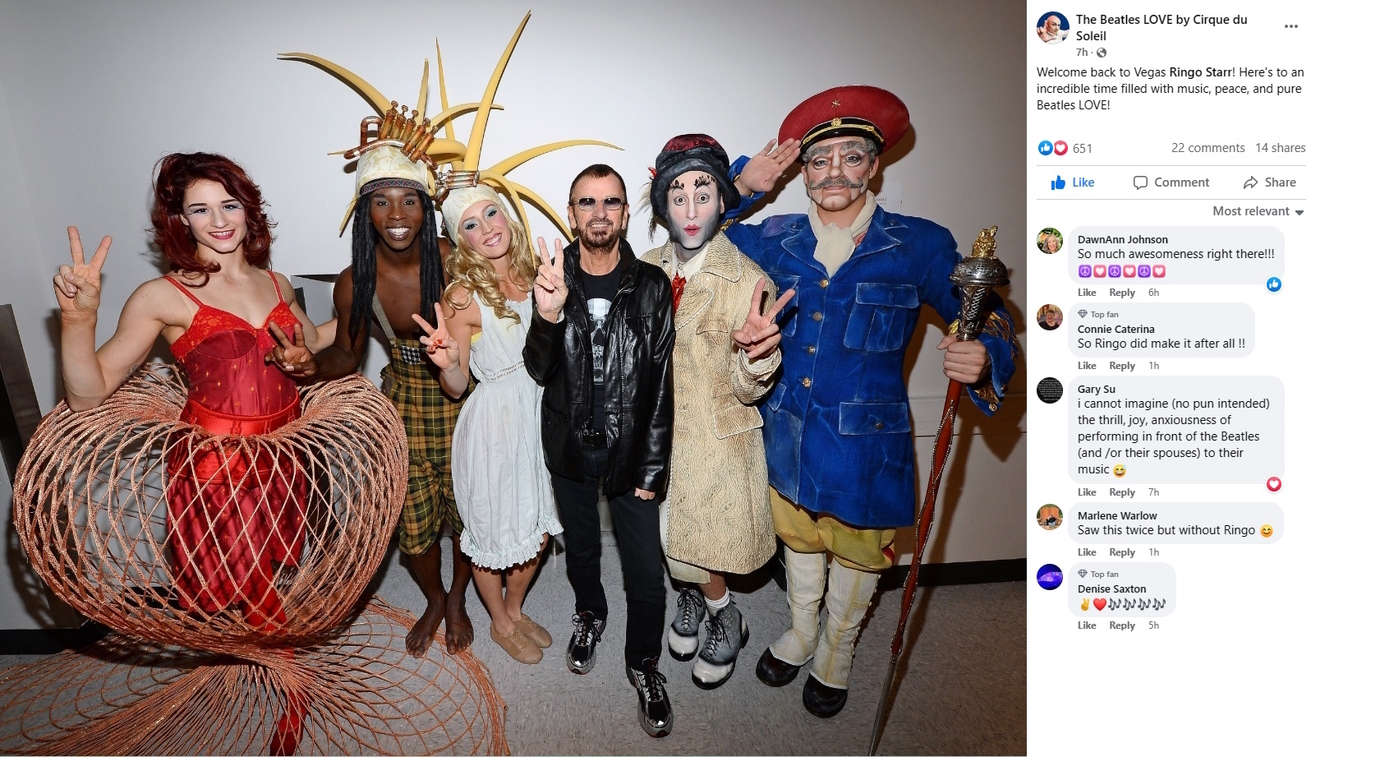 |
British-American Dialog Flourishes In Music Market And it started with Beatlemania of the 60s
by Tony Jasper for Billboard Magazine
 |
The following is from Music Business, August 8, 1964
 |
 |
 |
 |
 |
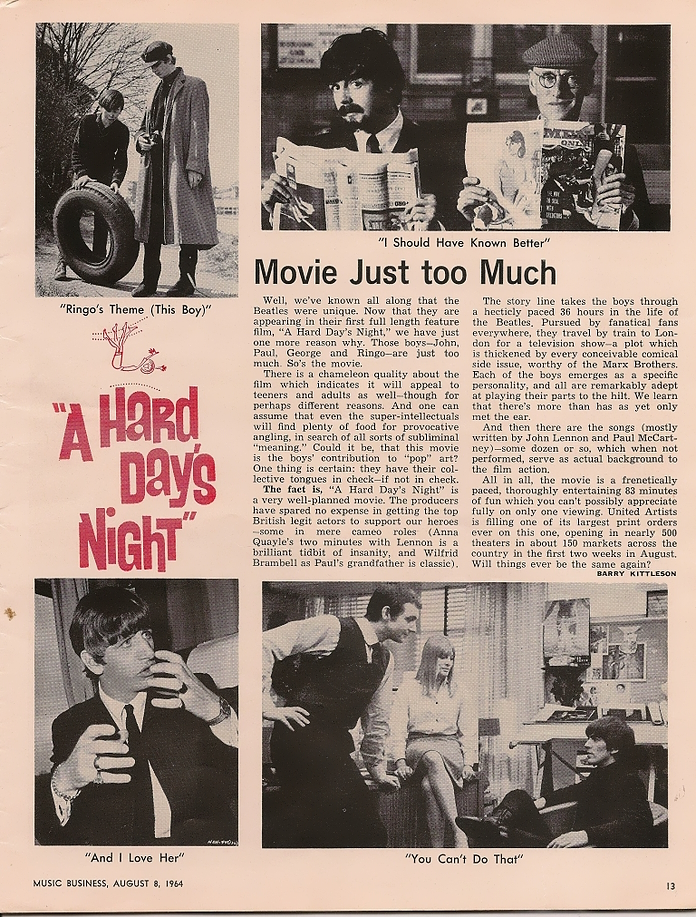 |
 |
 |
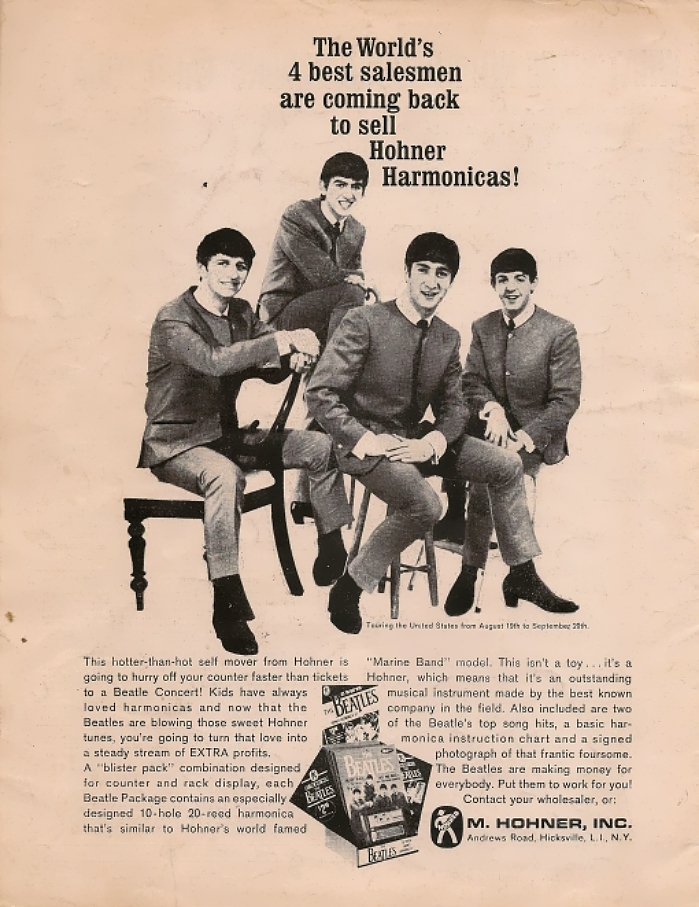 |
TV Guide's coverage on the Beatles Anthology, November 18, 1995
 |
|
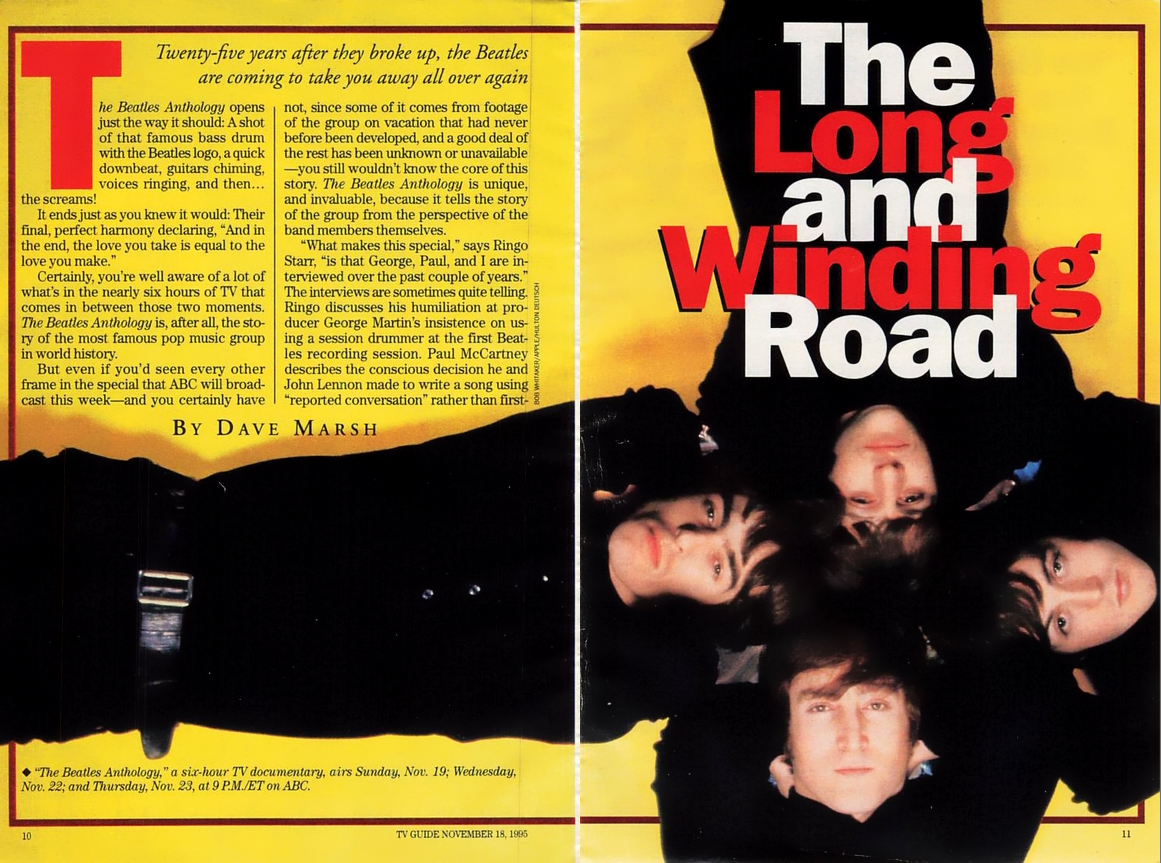 |
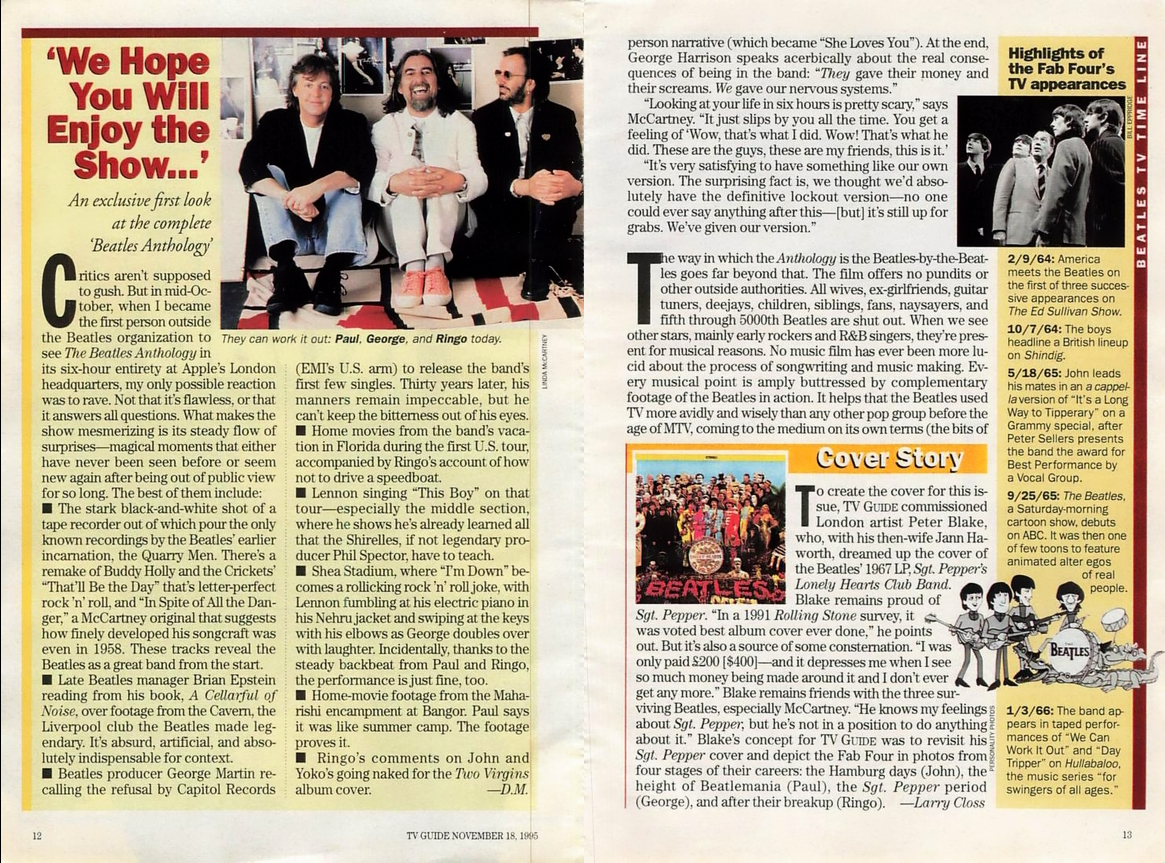 |
 |
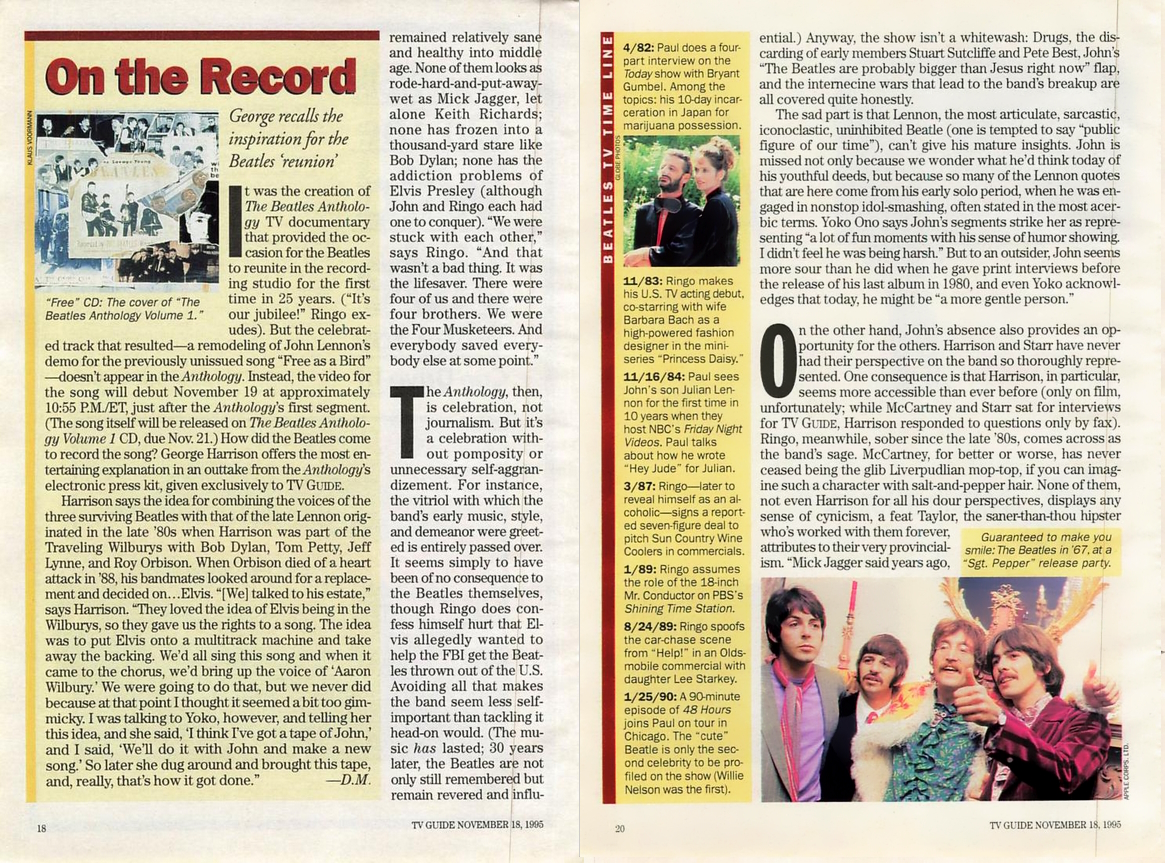 |
 |
The following articles on Ringo and Paul were taken from the January 1974 "Music Scene" magazine
 |
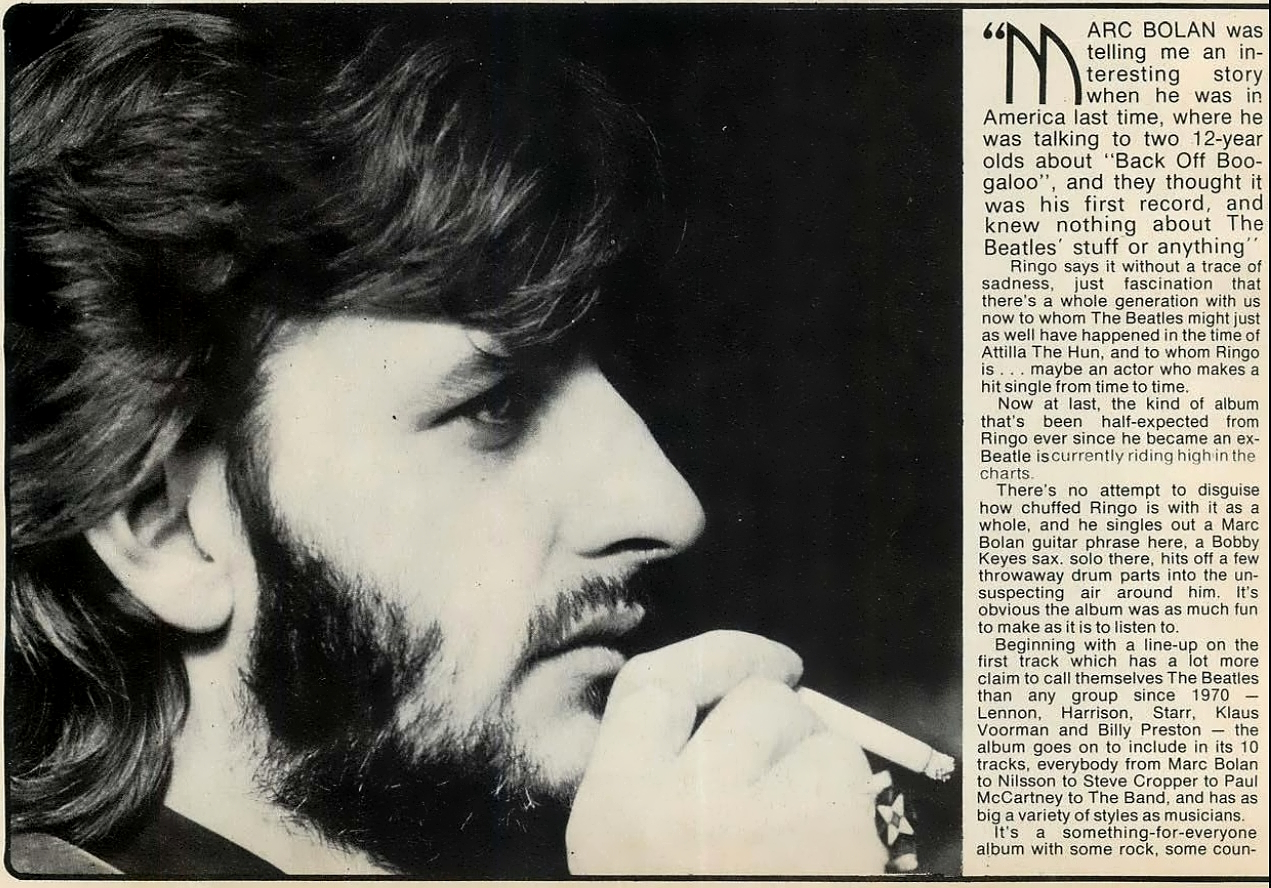 |
 |
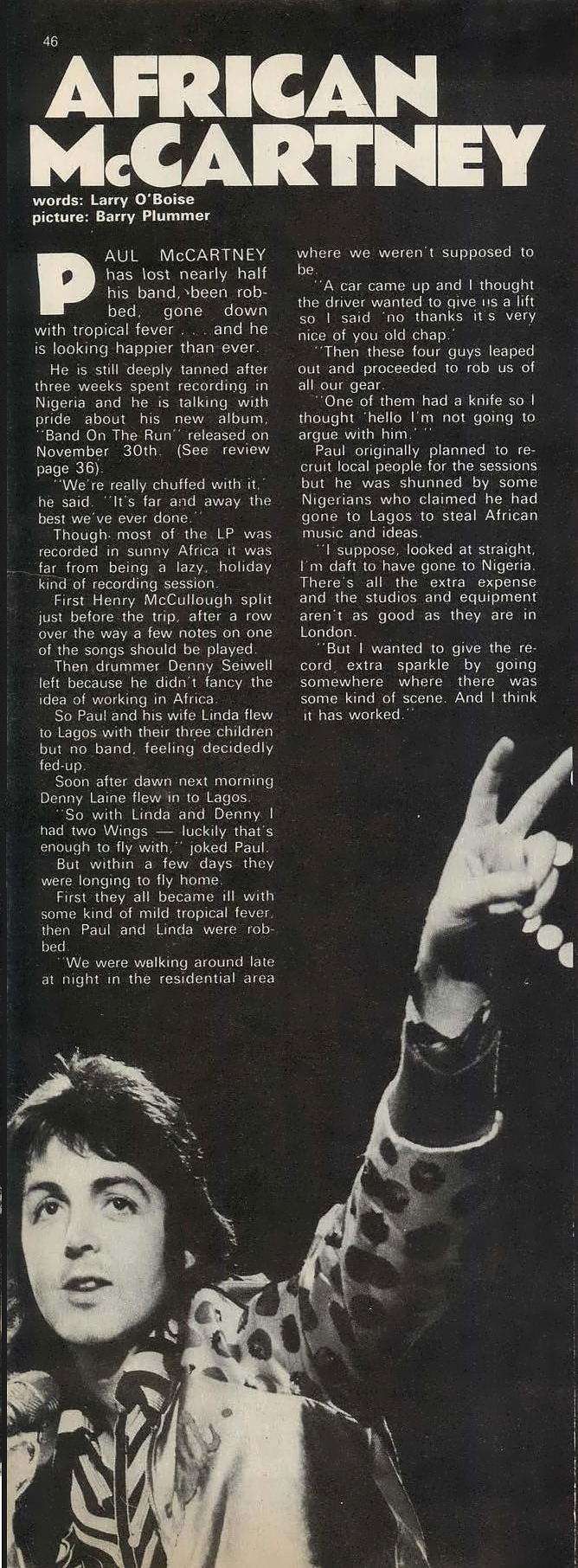 |
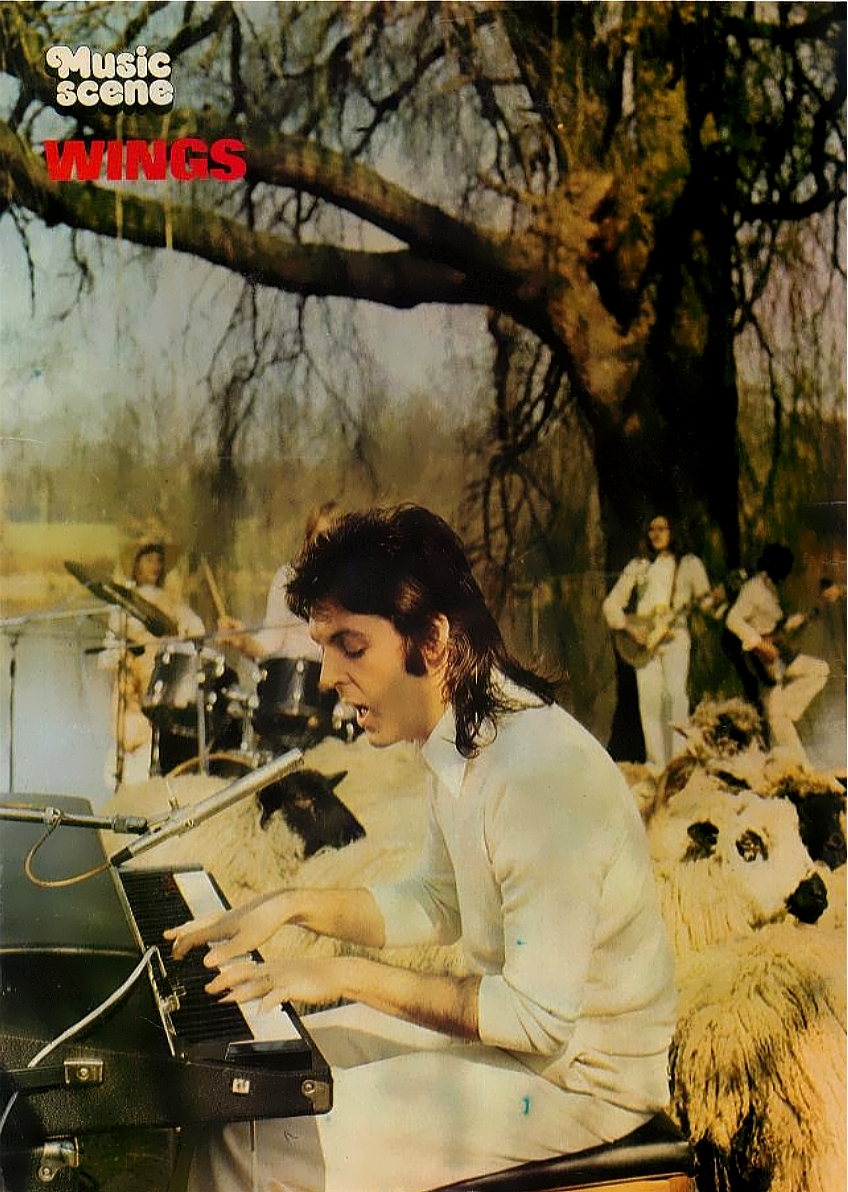 |
